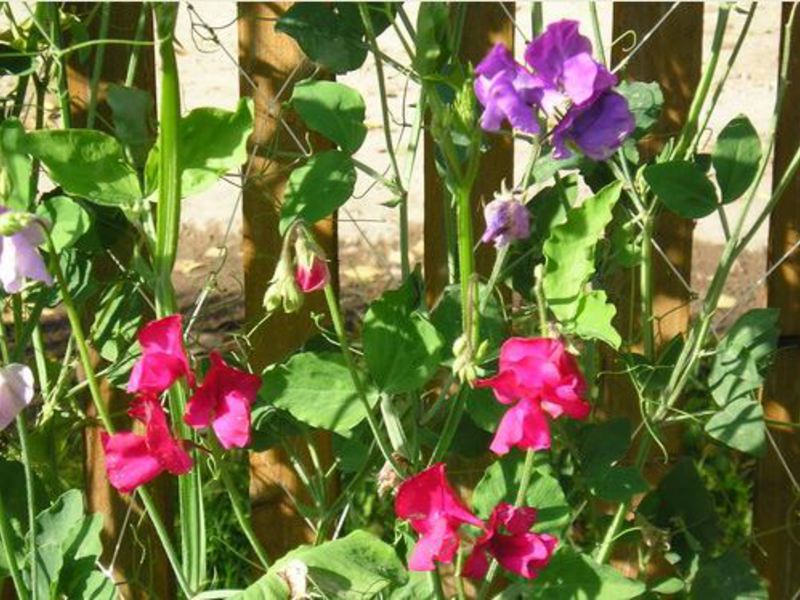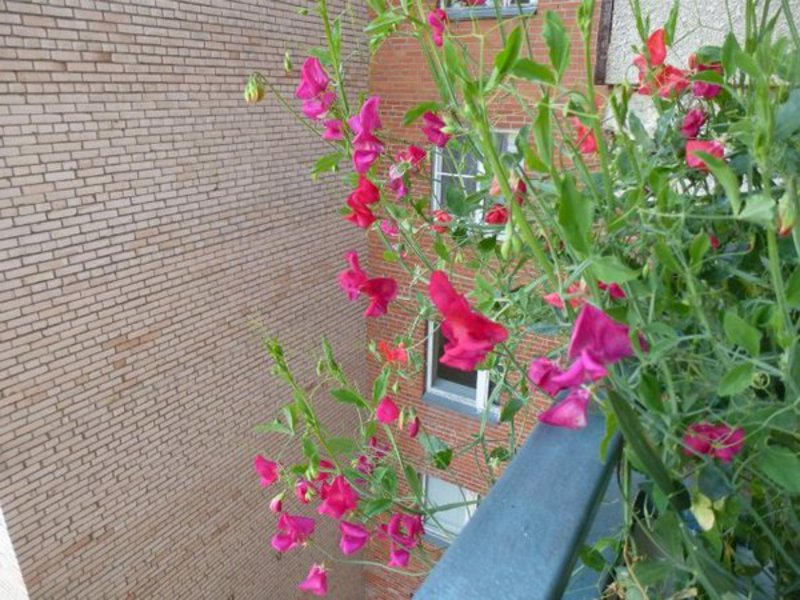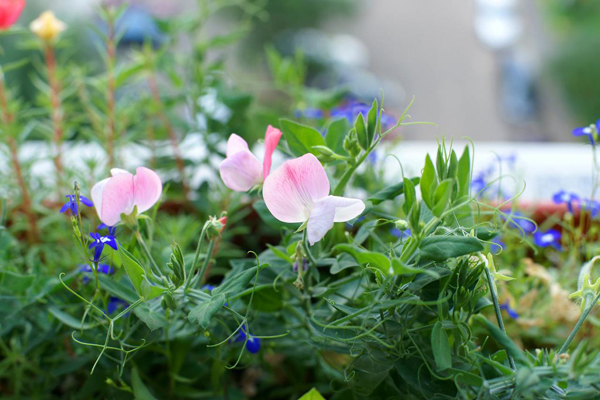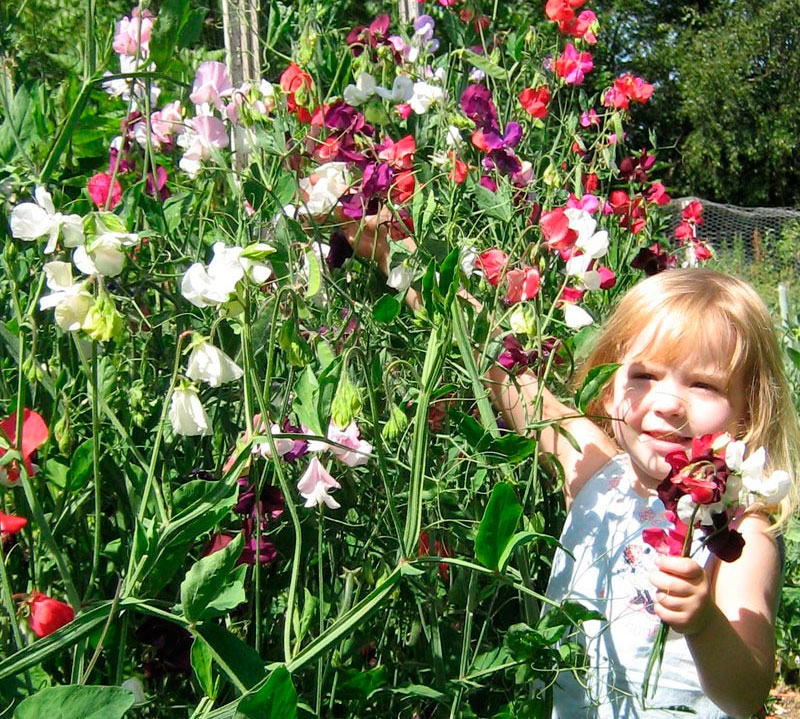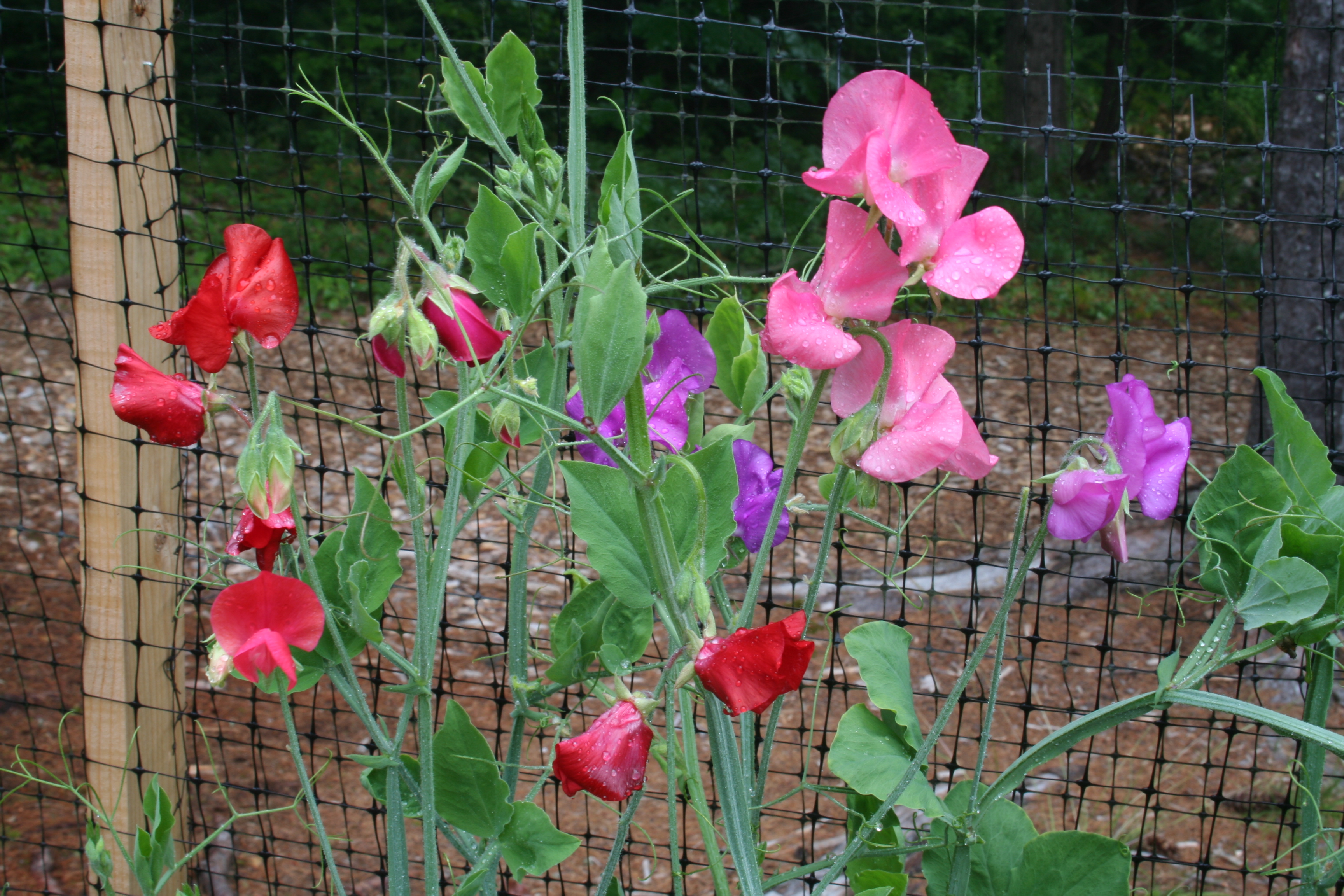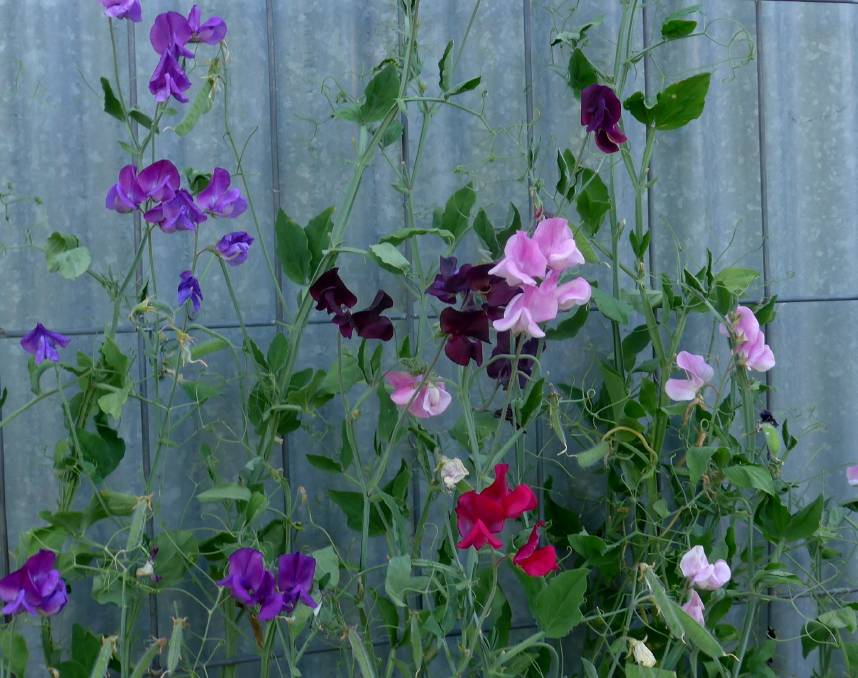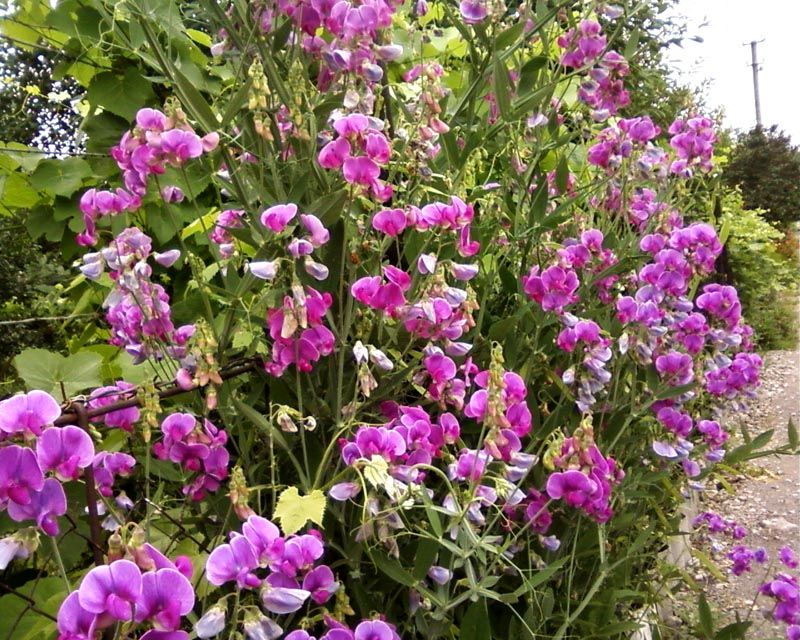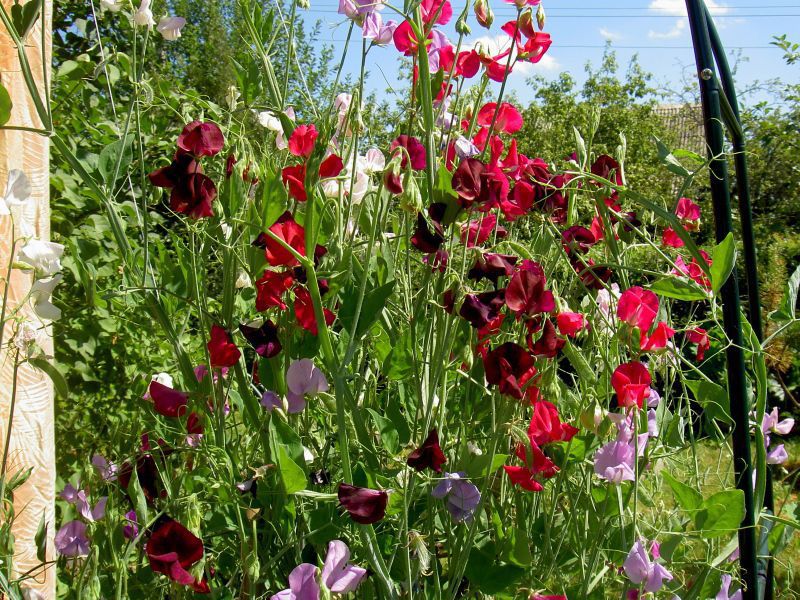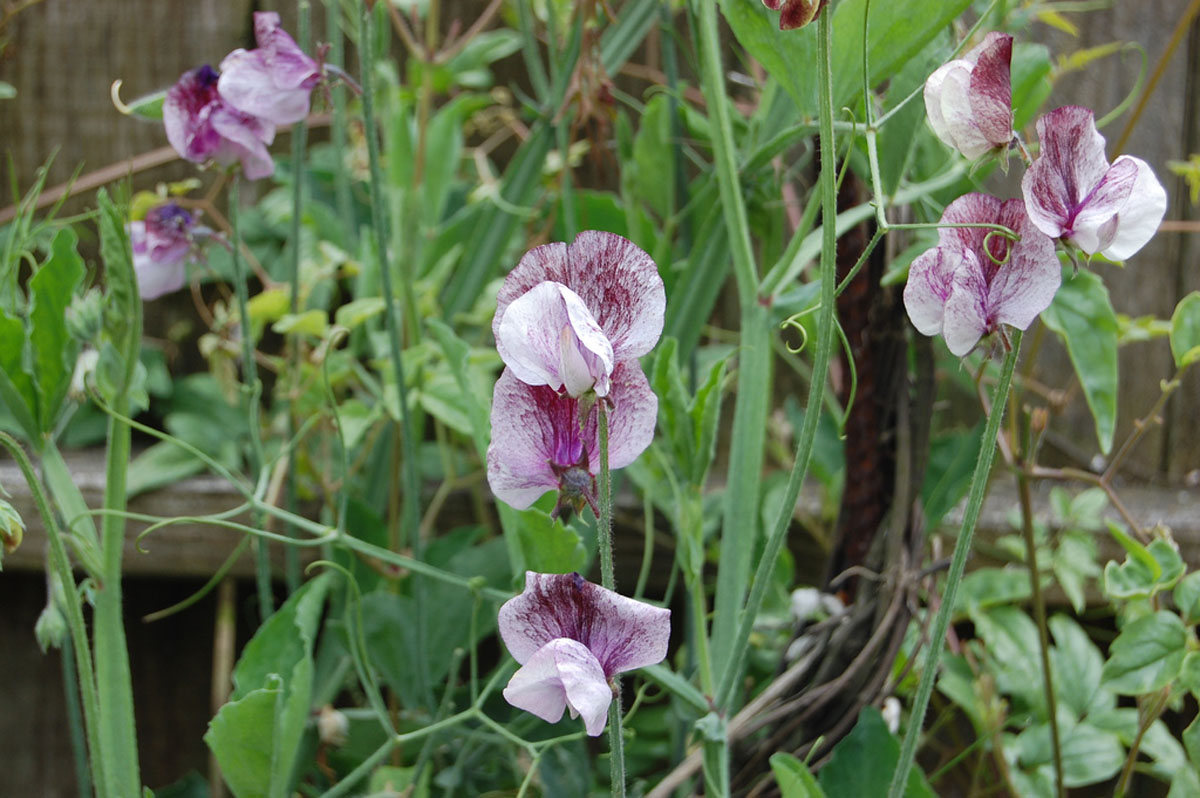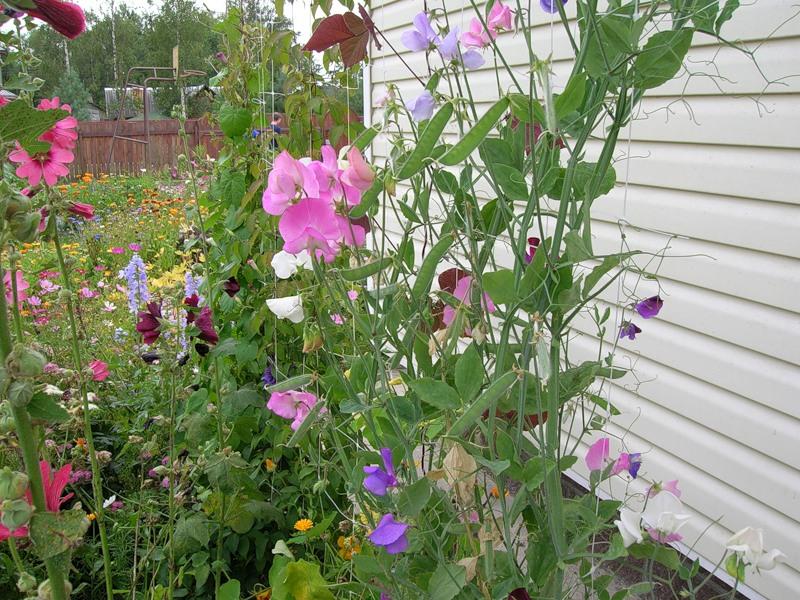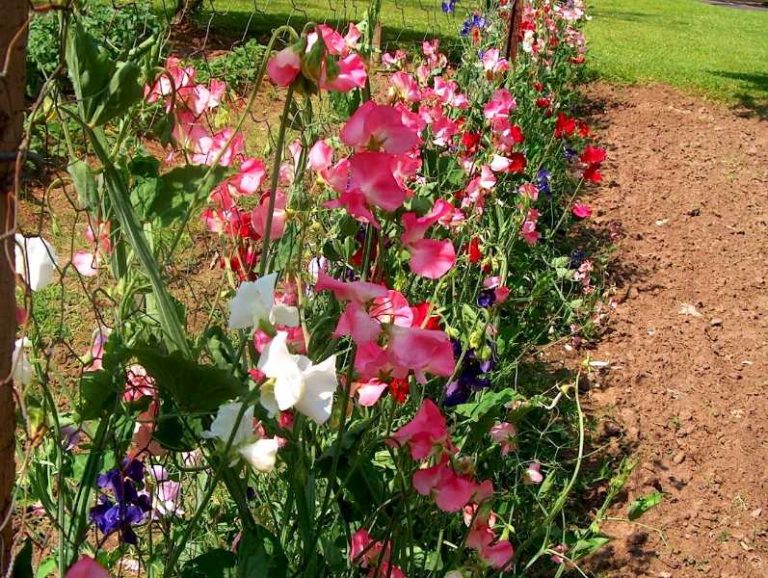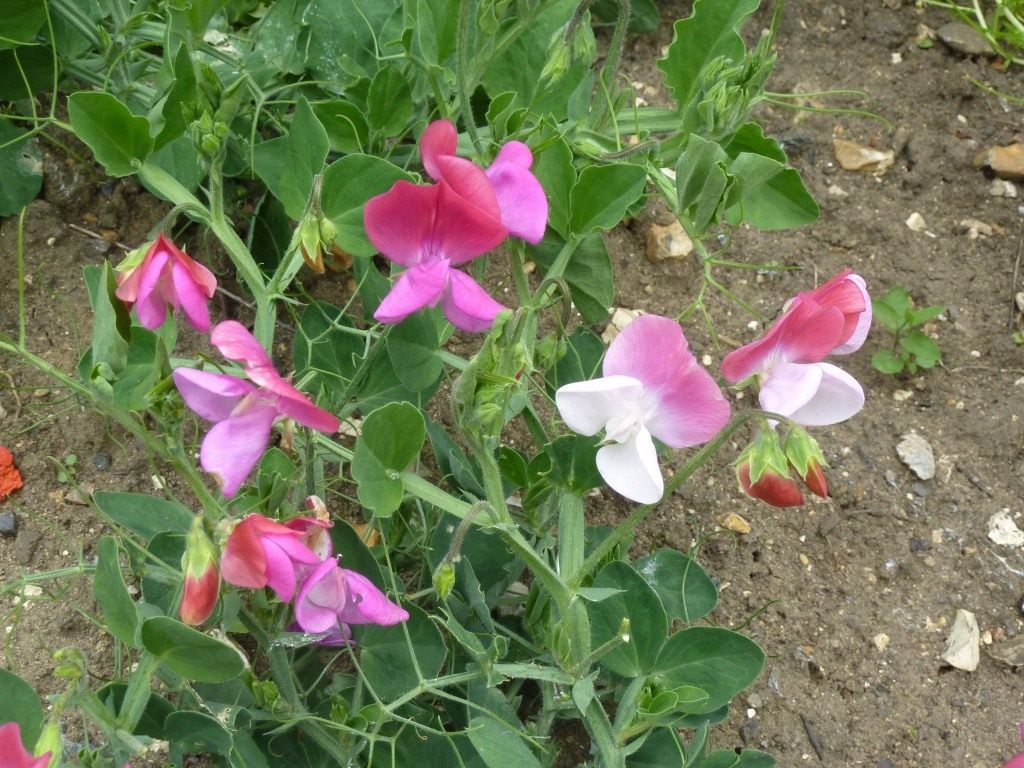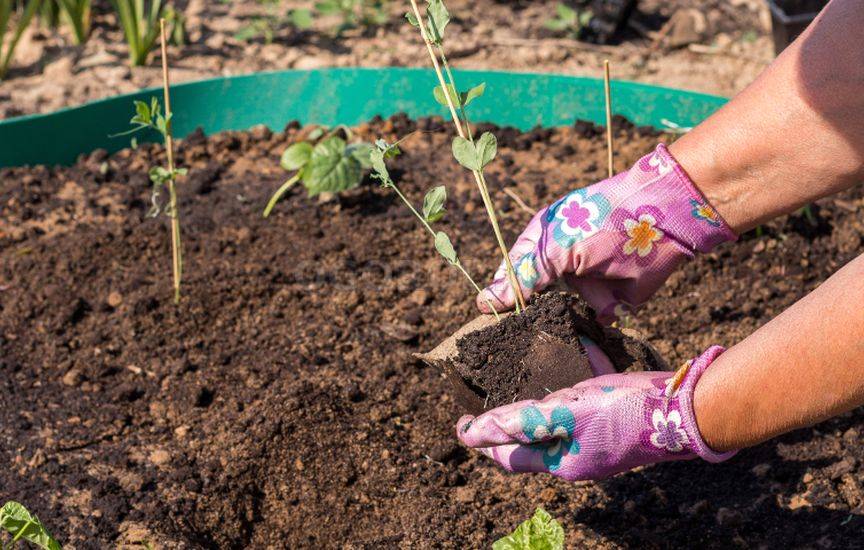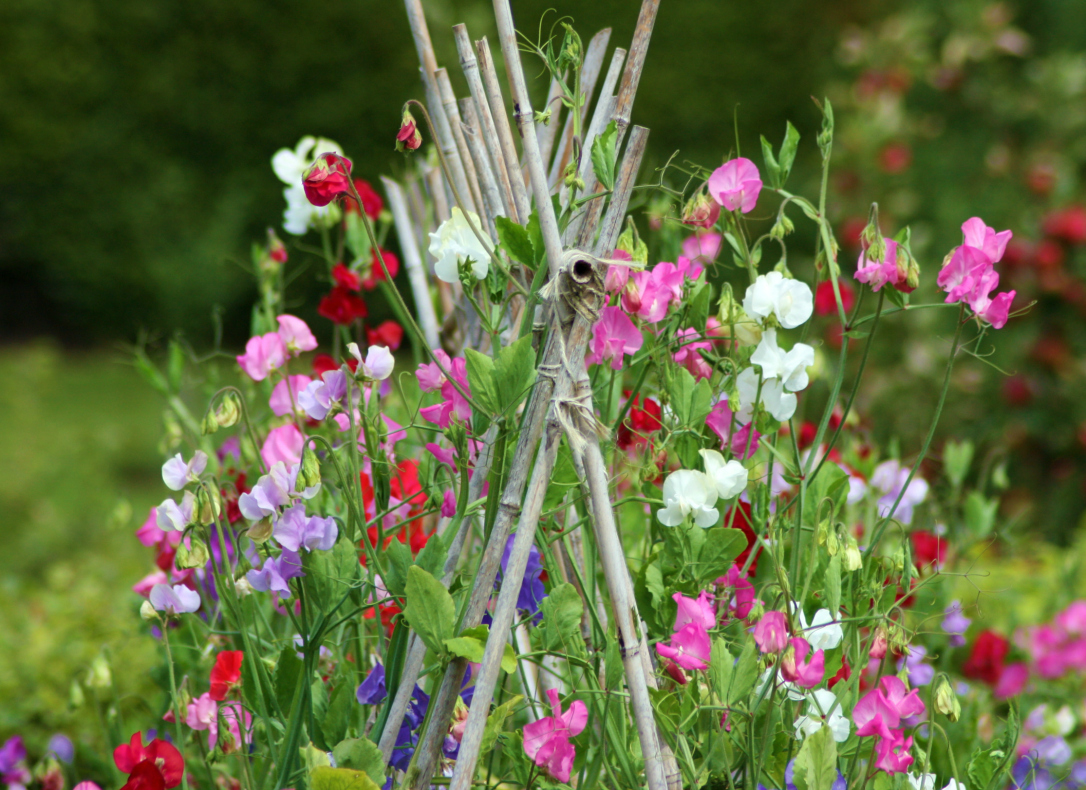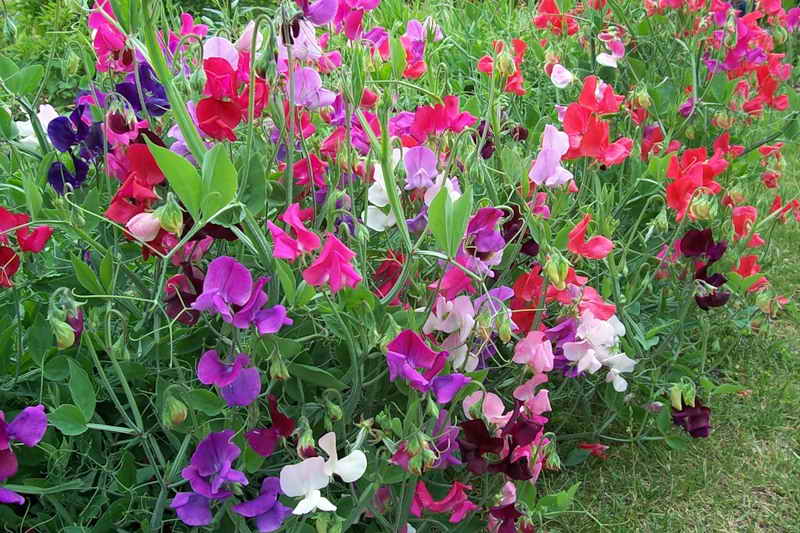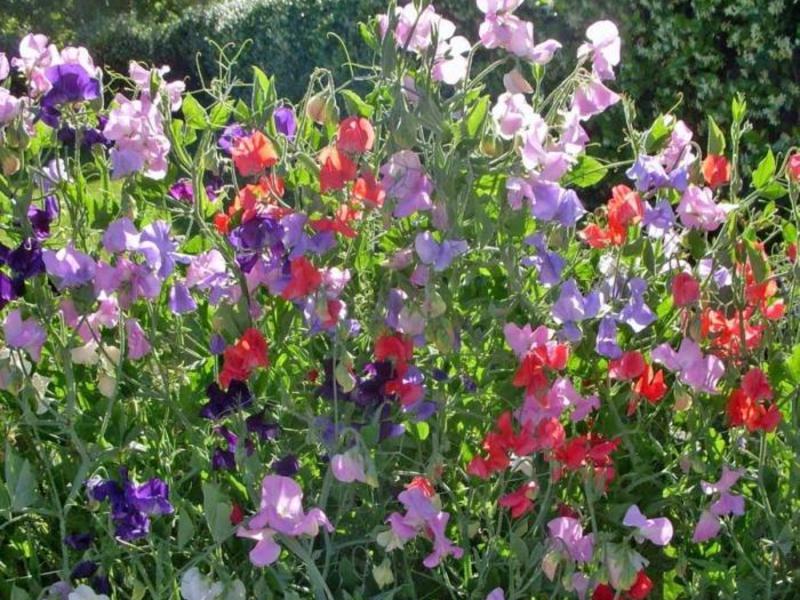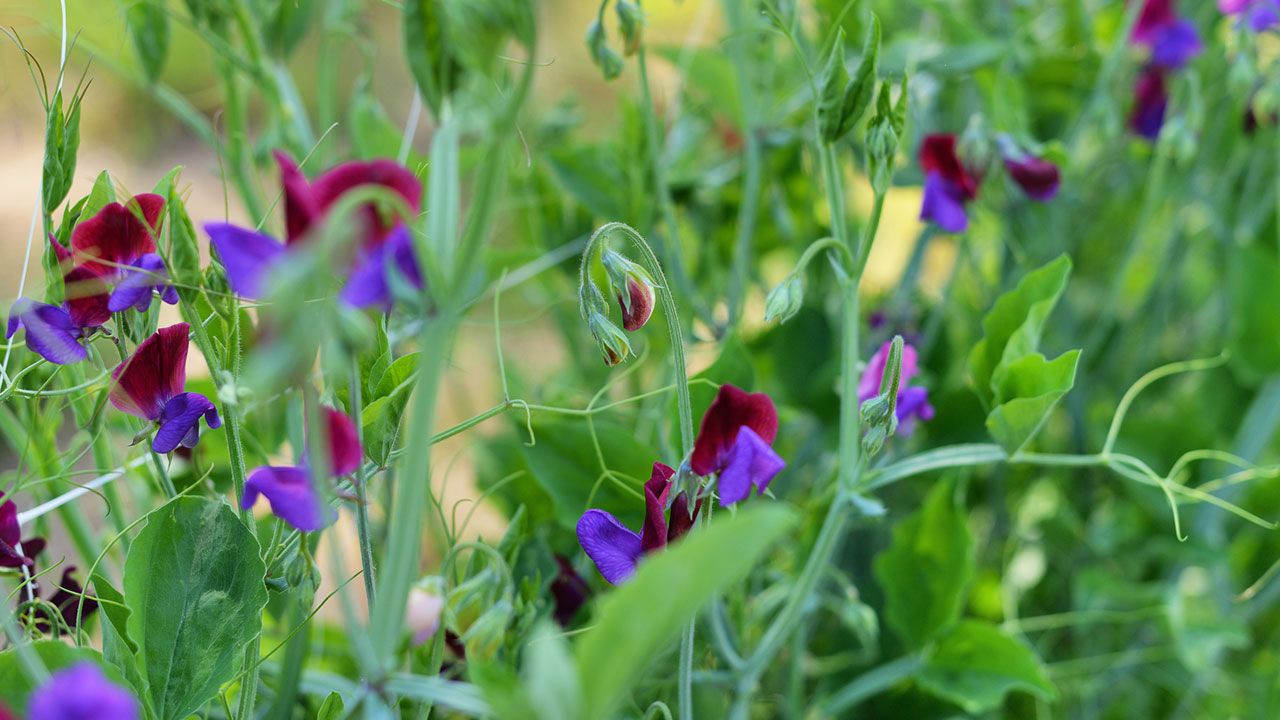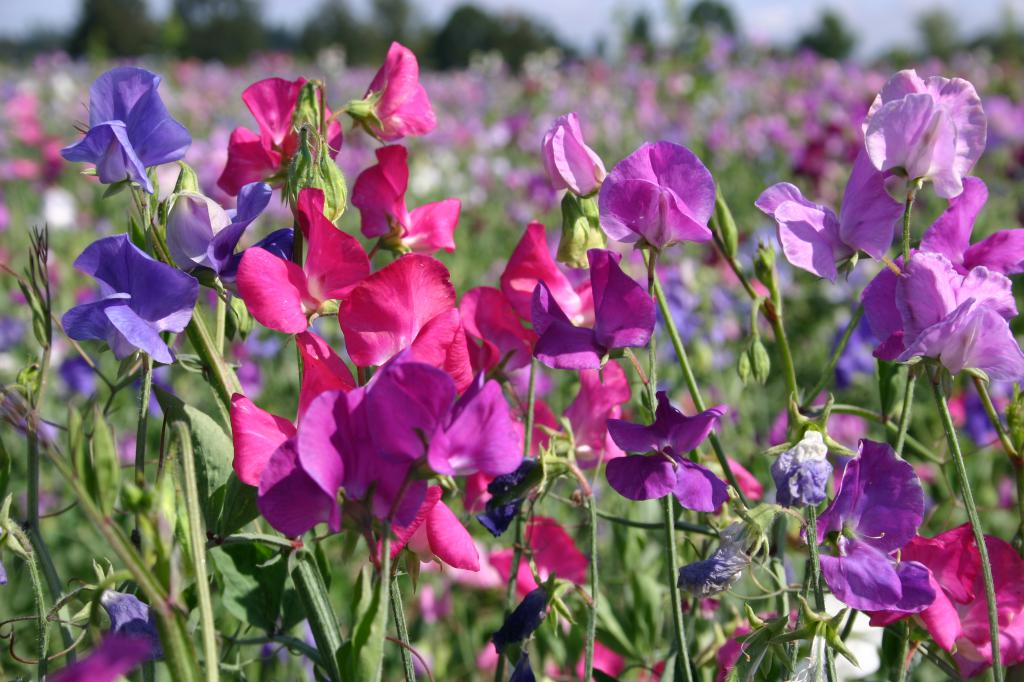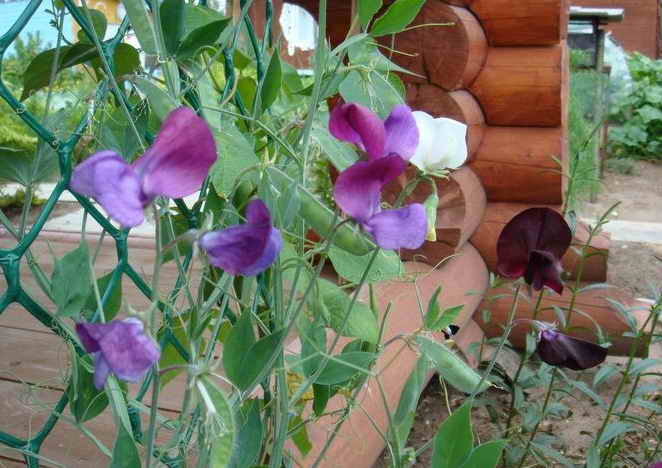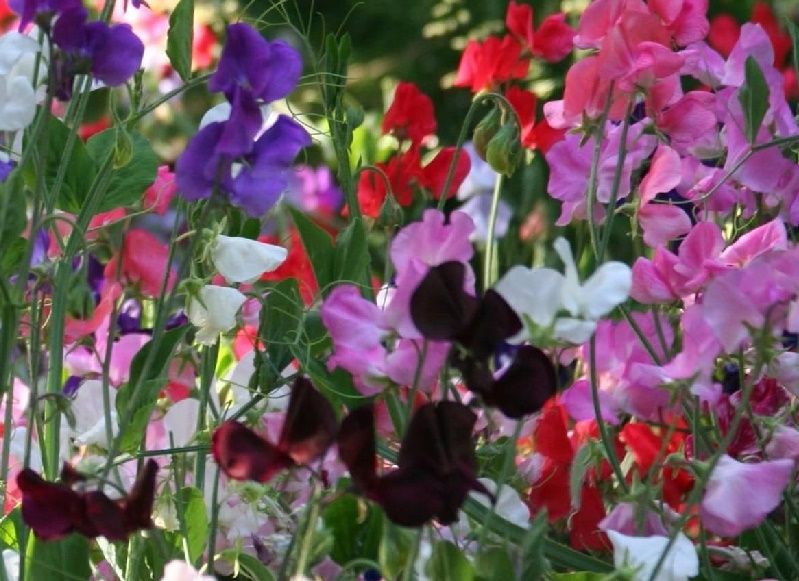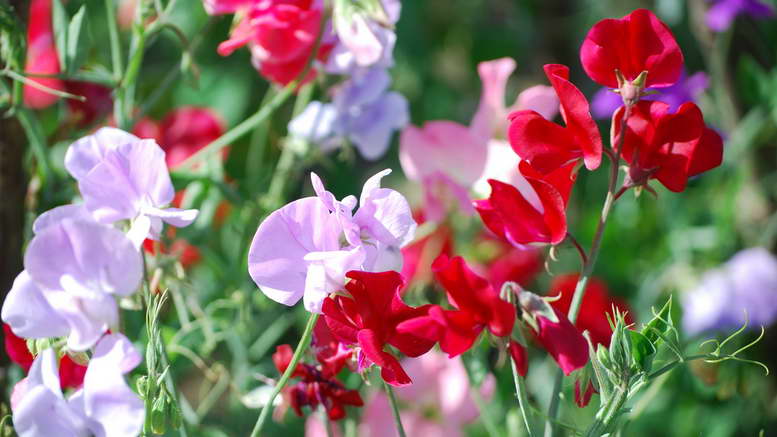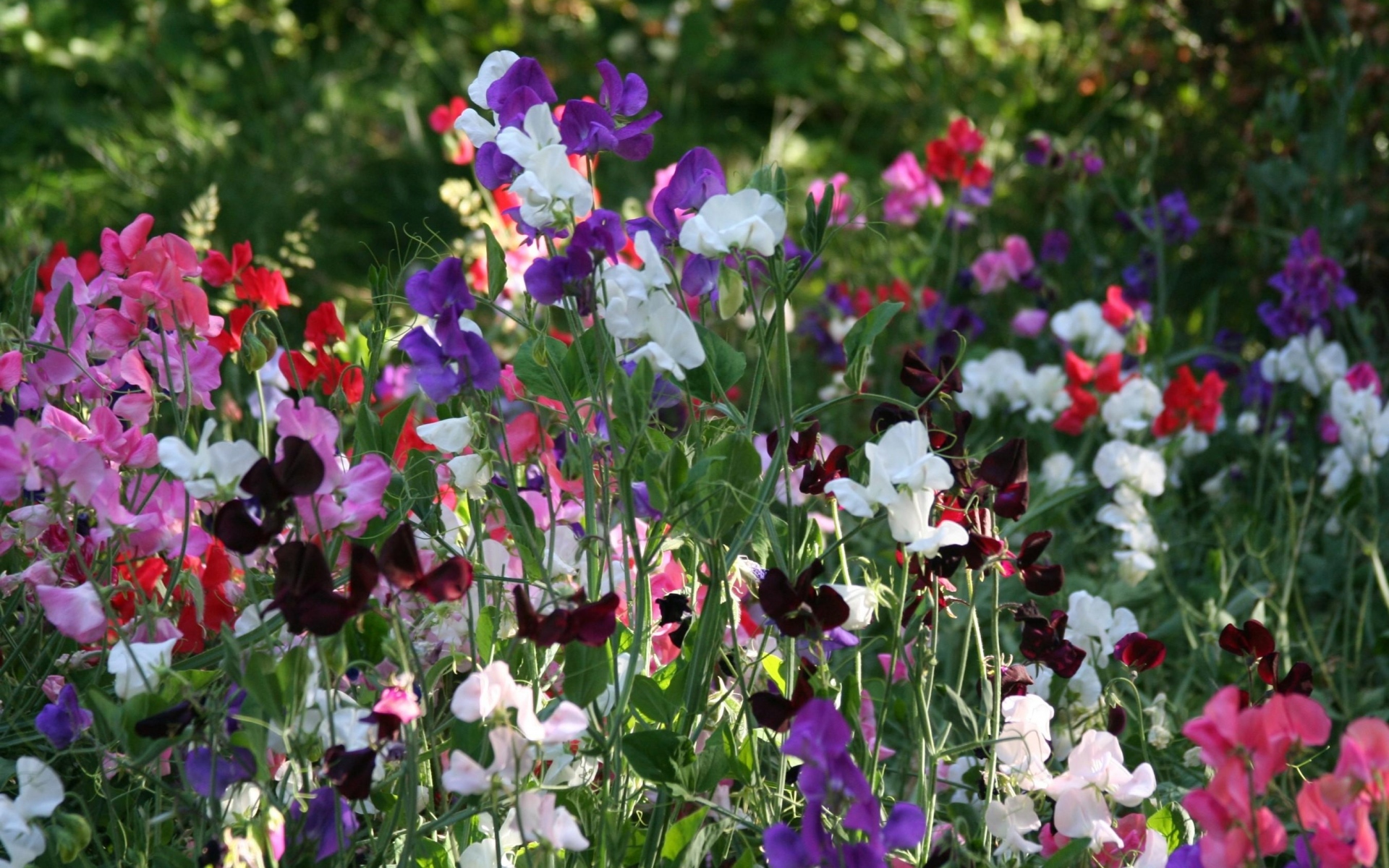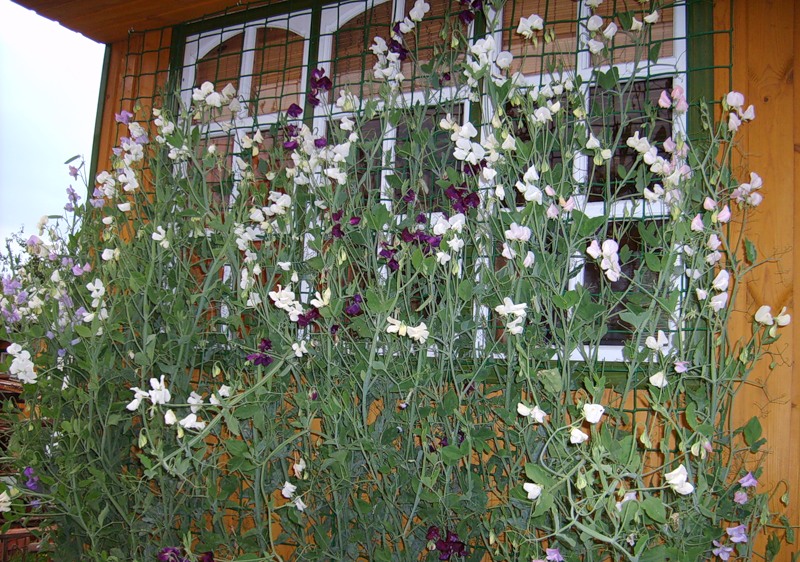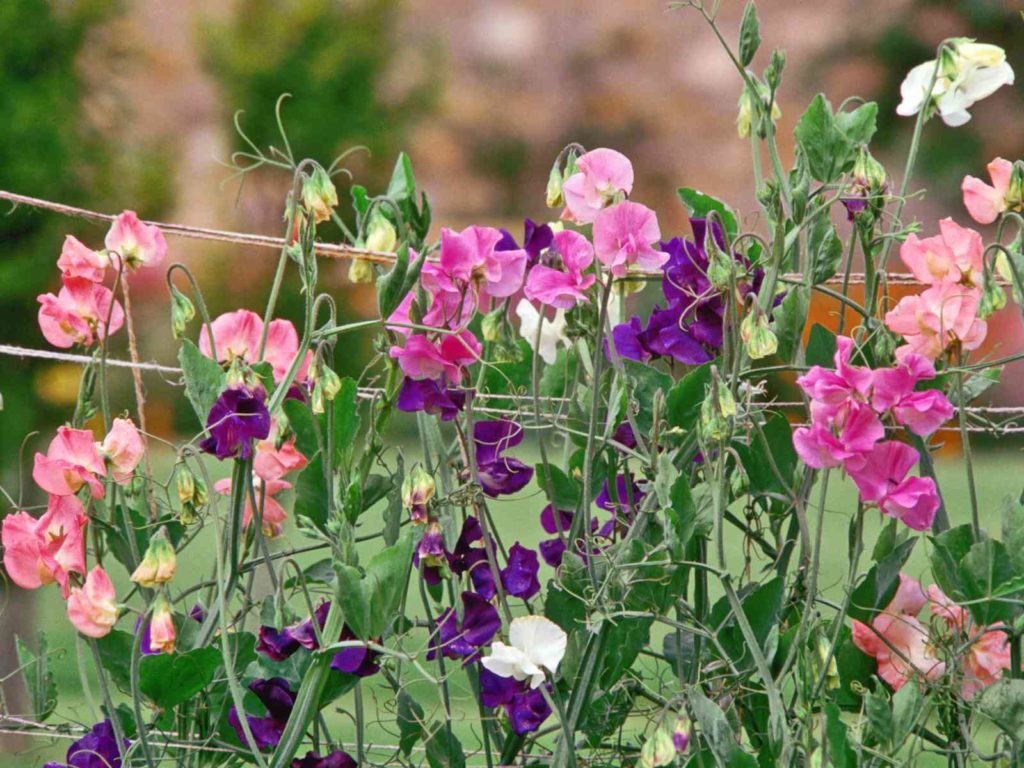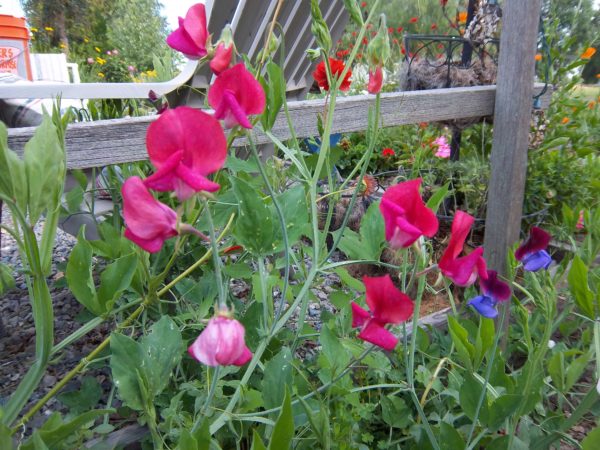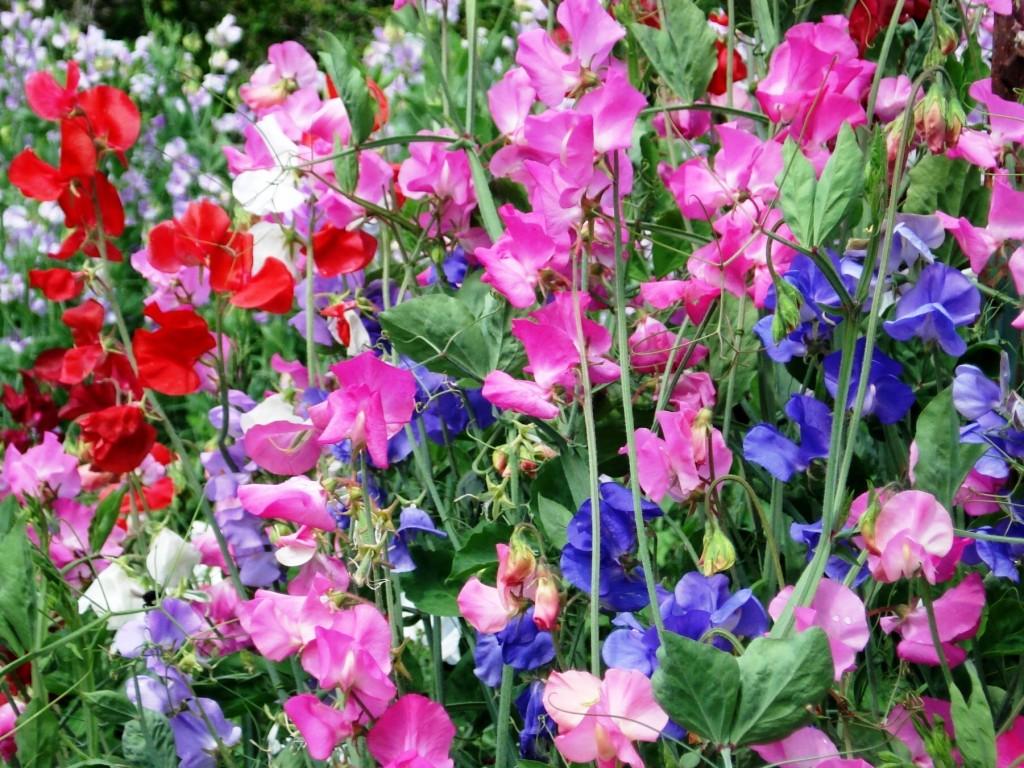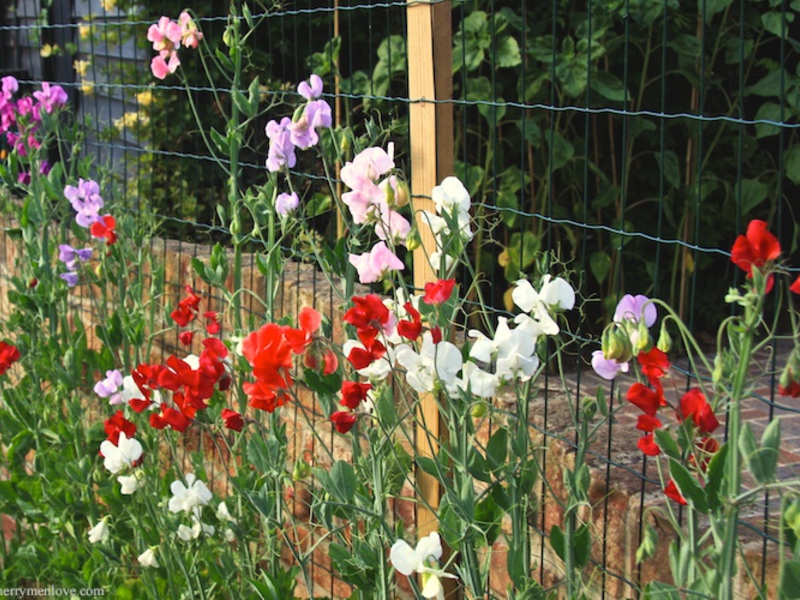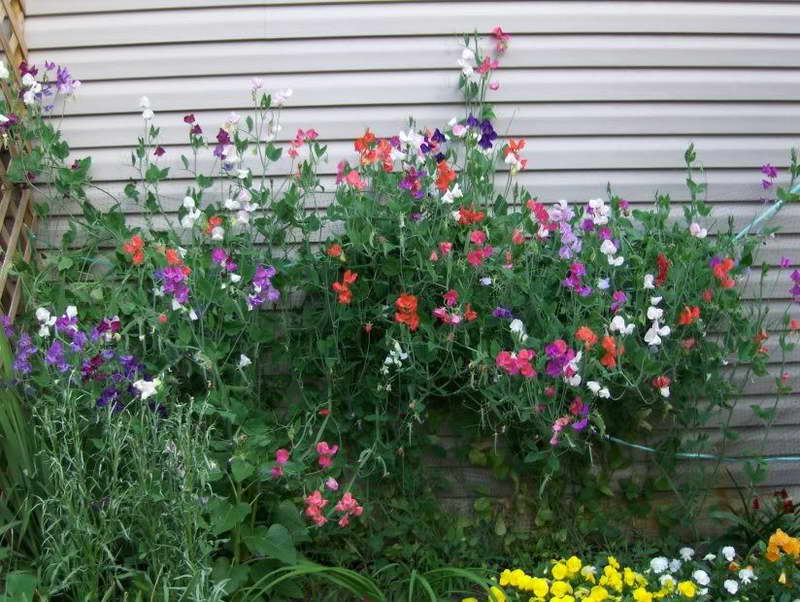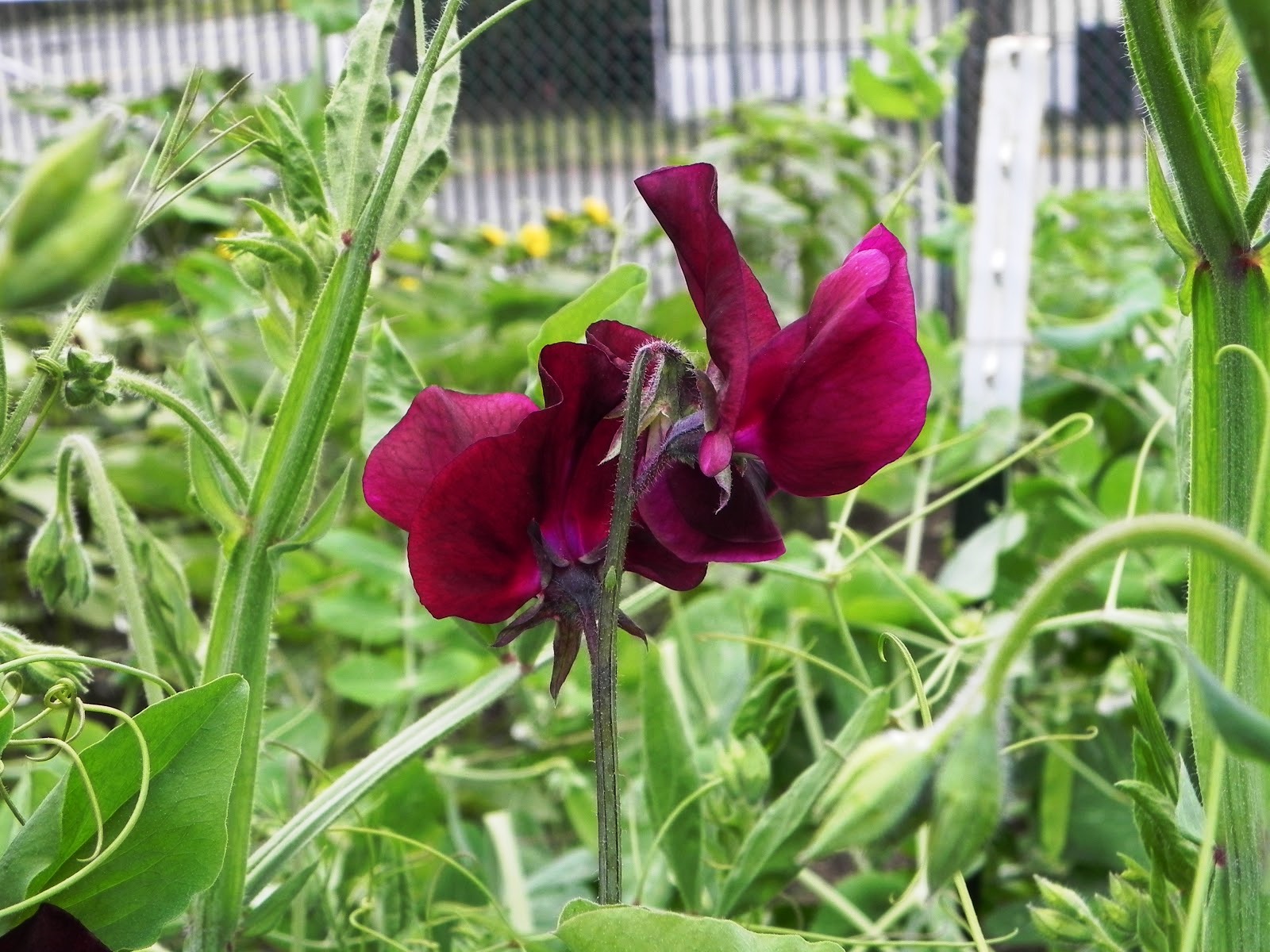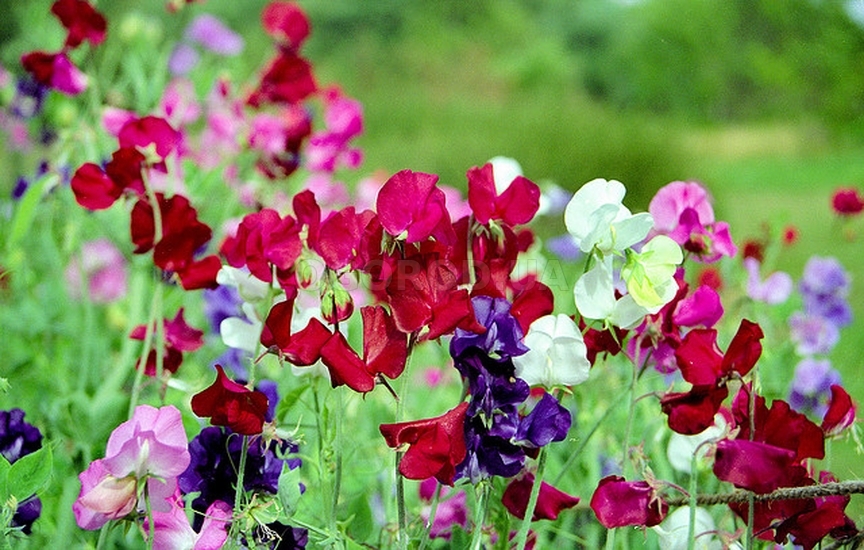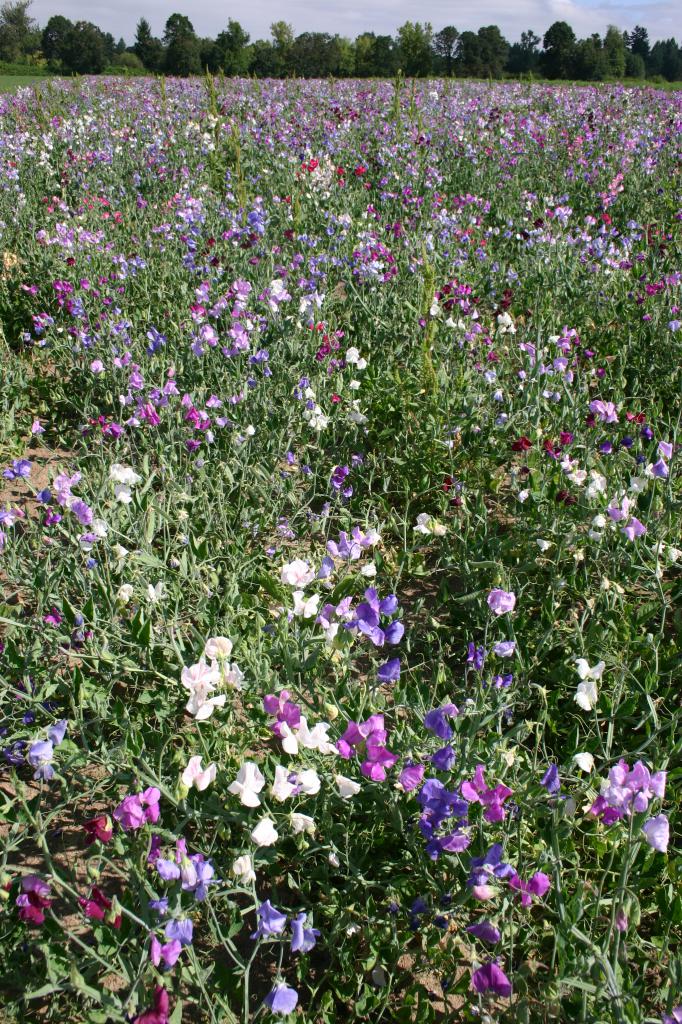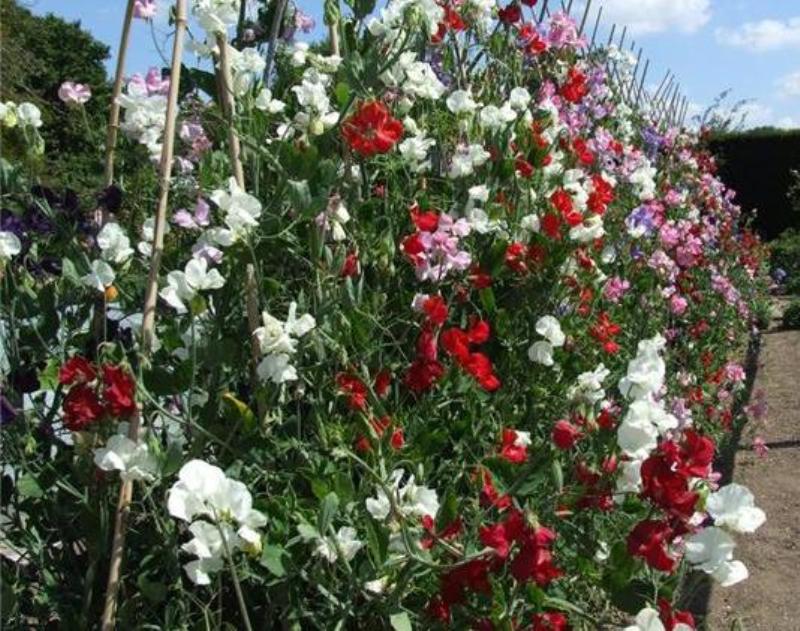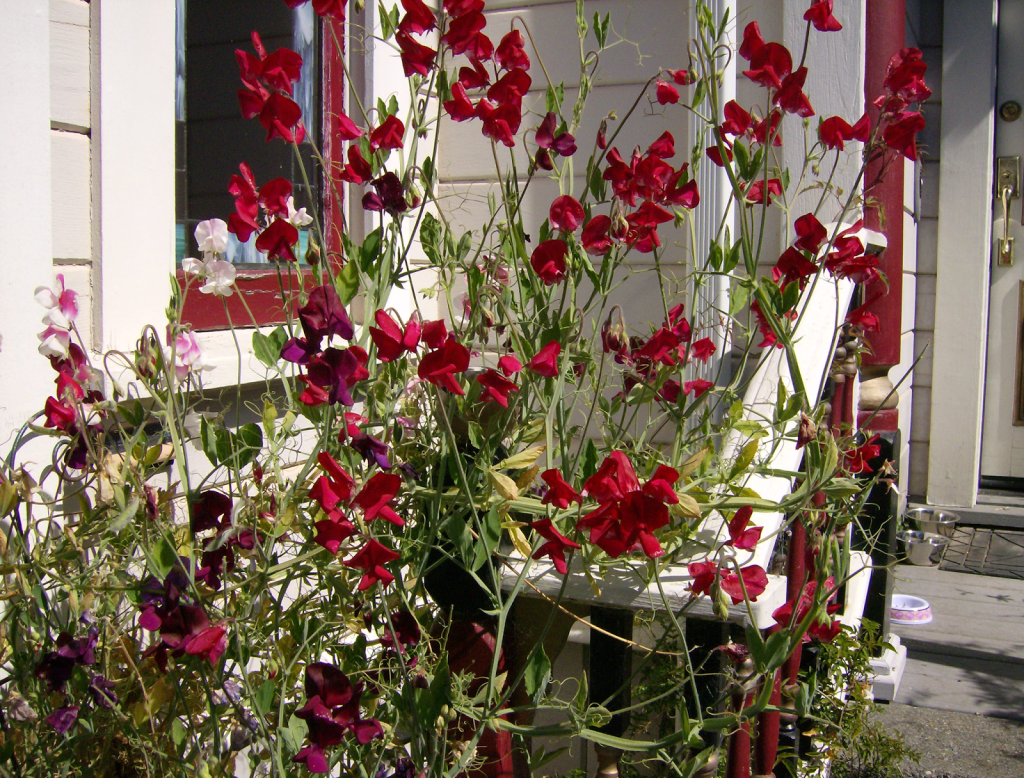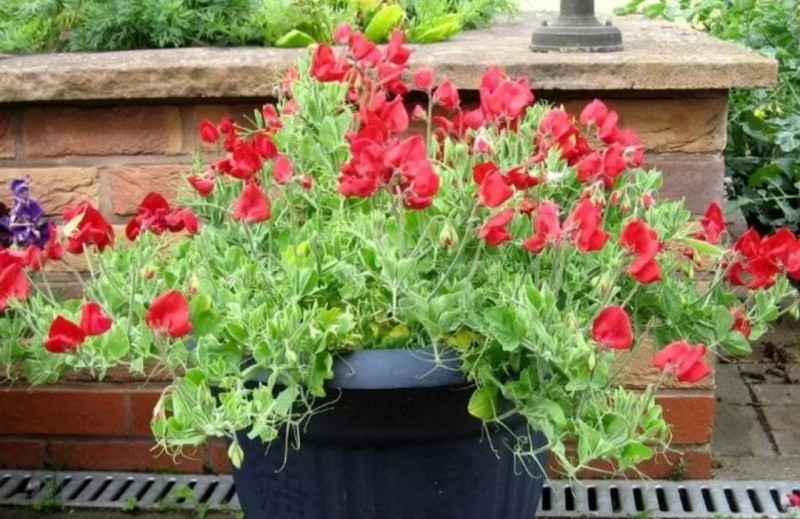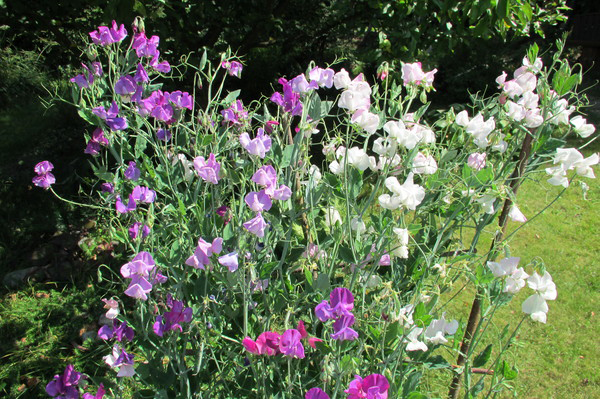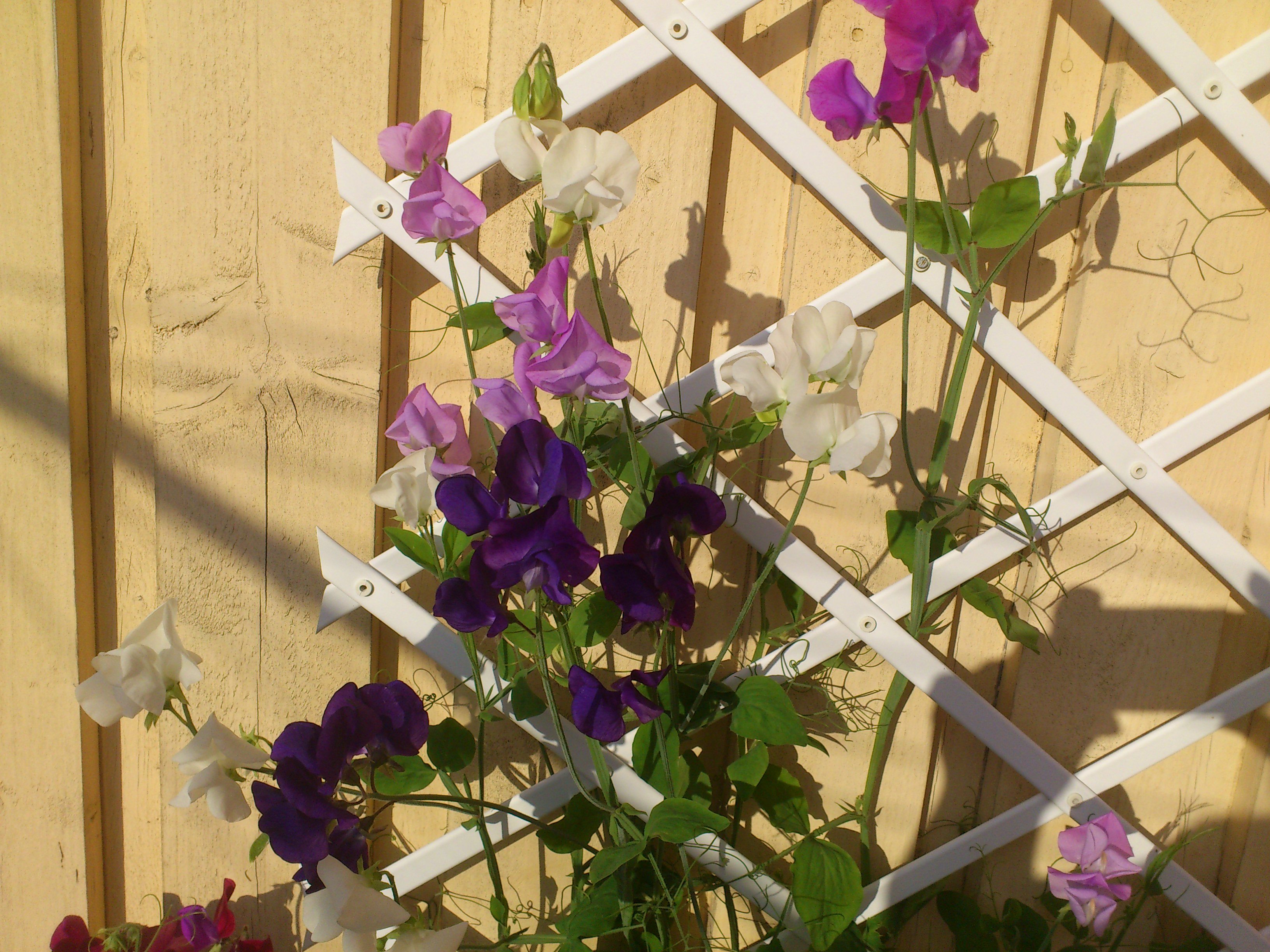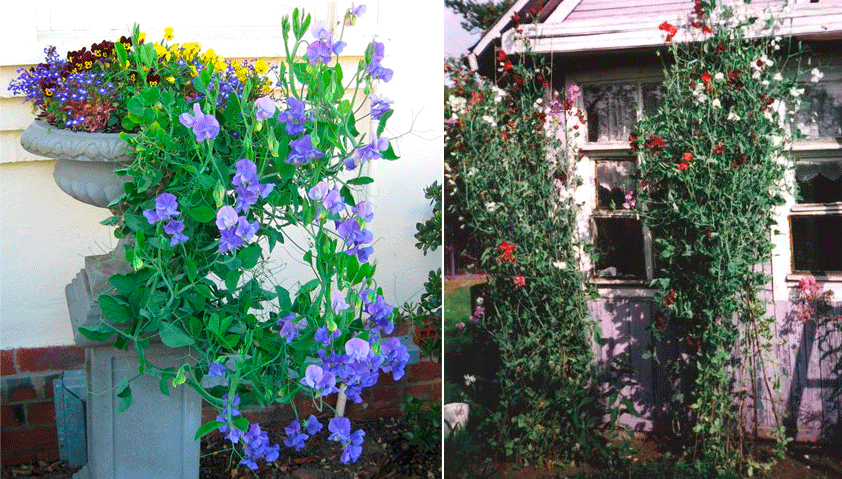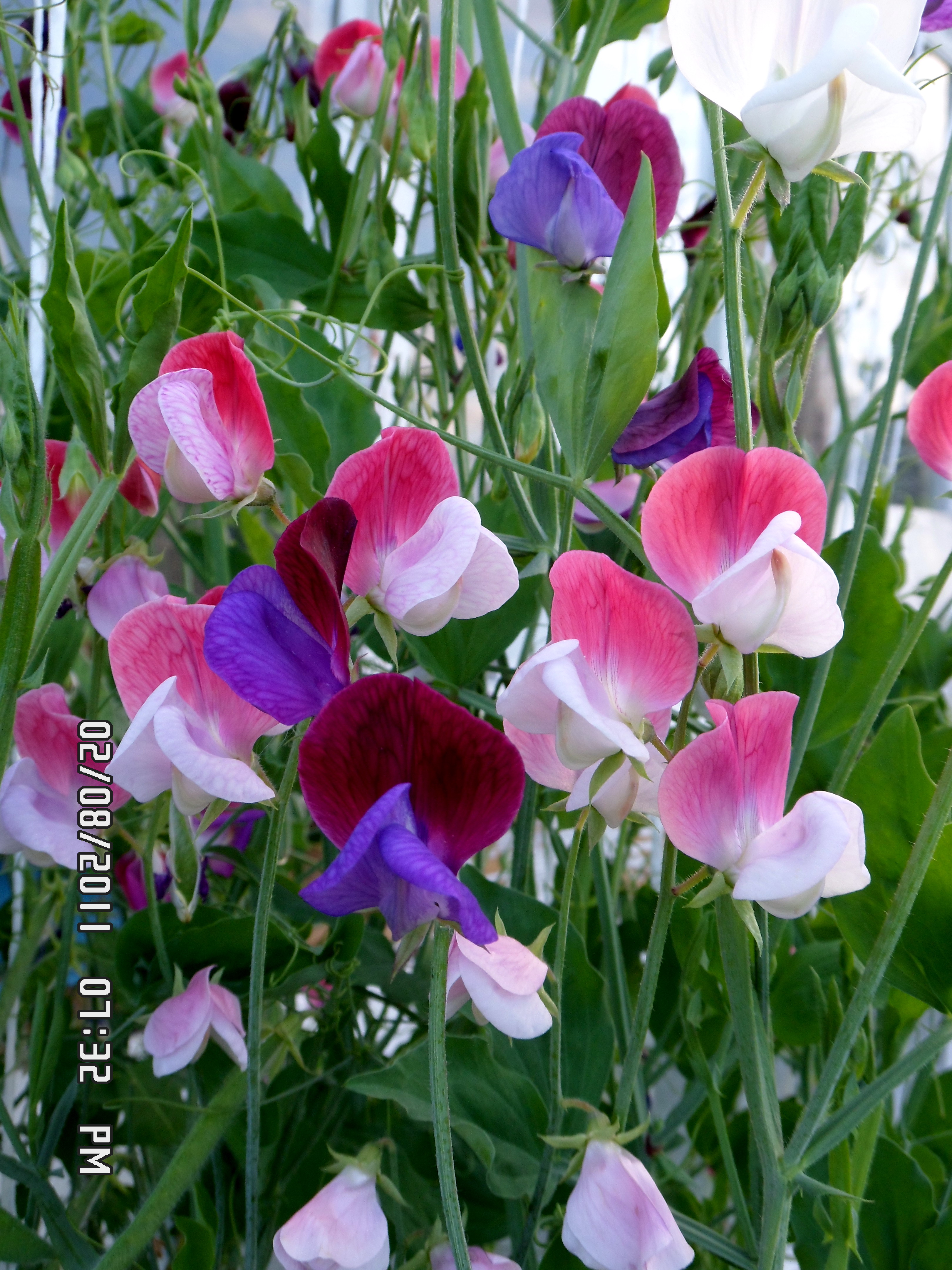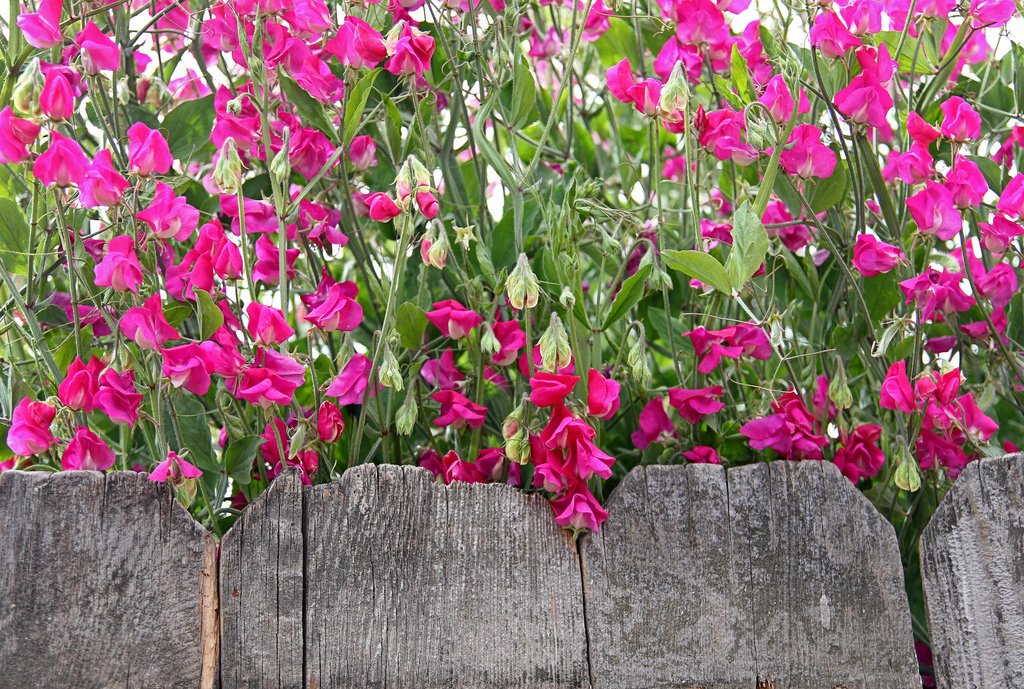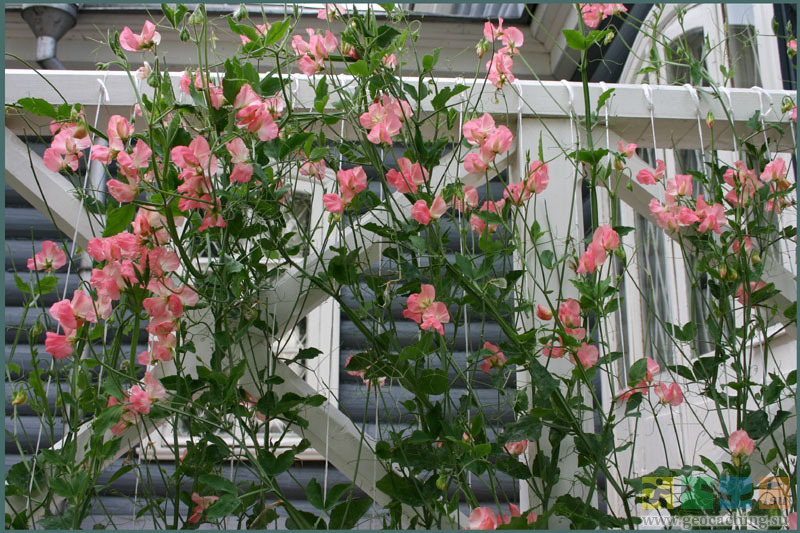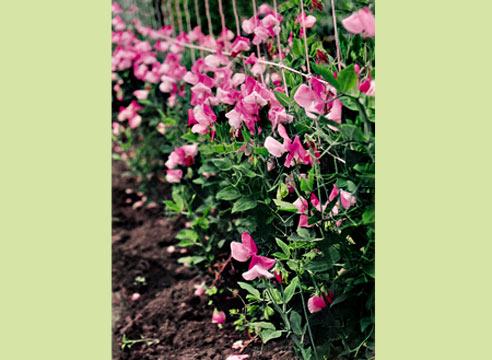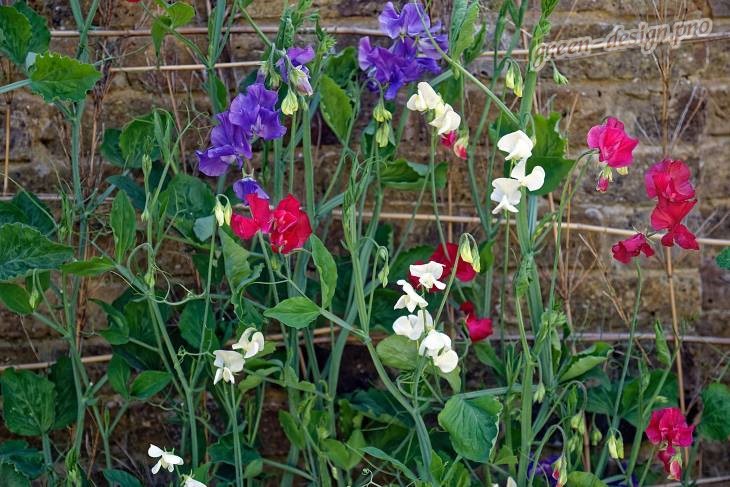Flower care
Plants are undemanding to care and easily put up with the mistakes of novice gardeners. A very important point is the choice of a landing site. Polka dots prefer good lighting, light partial shade is possible. The more sunlight the liana receives, the larger, more beautiful and richer in color the buds will be.
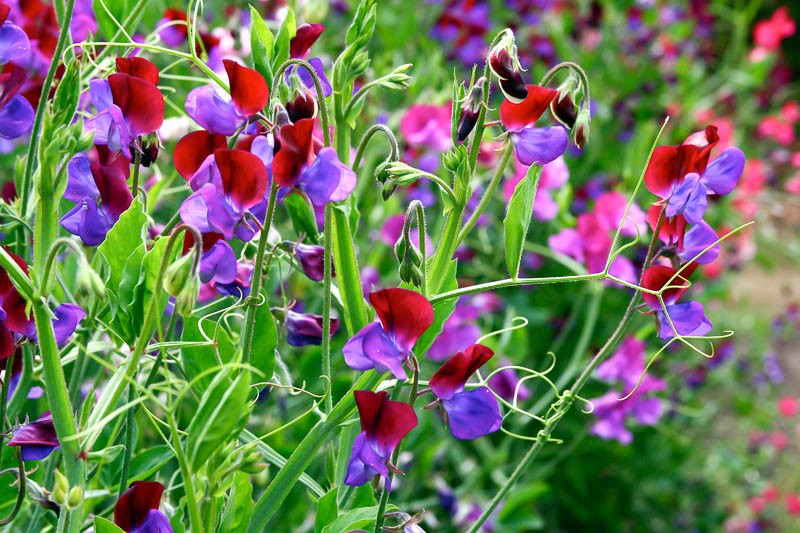
Flowers love moderate watering, but cannot stand moisture stagnation in the soil. When planting in balcony boxes, good drainage is required. Before transplanting into the ground, garden soil is mixed with peat or old humus, and then carefully loosened. A neutral or slightly alkaline soil reaction is preferable; in acidified areas, preliminary liming can be carried out.
Immediately after transplanting, young plants of tall varieties are tied to a support. In order not to injure delicate stems, it is better to use soft strips of fabric or special plastic clips.
Regular hilling and adding humus to the base of the stem will help stimulate root growth. 1-2 times per season, it is possible to apply complex fertilizers based on phosphorus and potassium. To make the flowering more abundant, the wilted buds are cut off in time. Such an operation will help preserve the decorative effect of the vines. Several ovaries can be left on the lower branches to form seed pods, they are removed at the end of the season.
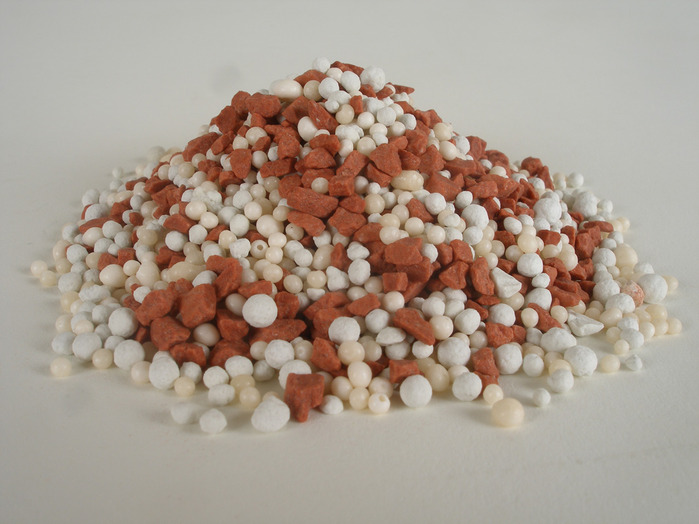
Polka dots do not need pinching and pruning. Only broken or deformed branches are removed. At the end of the season, the vines are cut to the root and composted. The roots of the perennial are covered with peat and sawdust, this helps the plant to successfully survive the most severe winter. If the peas were grown as an annual, the vines are removed along with the root.
When to plant sweet peas
In order to choose the conditions suitable for planting a given plant, first find out how well this particular variety tolerates the cold, how to plant sweet peas, what conditions are optimal for growing it. Do not delay the moment of planting, since the growing season for this plant is quite long.
In harsh winters, planting sweet peas can also be undertaken in February, but not directly in the open ground, but indoors. Thus, you can prepare the seedlings in advance for the beginning of the gardening season - for planting after the snow melts in a permanent place of growth. In temperate climates, it is recommended to soak seeds in April-early May. At the same time, depending on the current weather conditions, you can plant sweet peas in open ground from early April to early summer.
How to grow properly
Before you start propagating a crop, you need to check the viability of the seeds. To do this, they are placed in a glass of salt water. The floating planting material is not used.
Selection and sowing of seeds
The culture is sown in early March for seedlings or in May in open ground. Another option is in the fall, when persistent cold weather sets in. If the procedure is performed earlier, the planting material may rise prematurely and freeze. Dry sweet pea seeds tolerate winter frosts well.
How to choose the right planting material
Seeds of your favorite pea varieties are purchased at a flower shop
It is necessary to pay attention to the date on the packaging with the expiration dates of the planting material. Expired seeds should not be purchased
High-quality material should be dry, without dents and rotting fragments.
Preparation of containers and soil
For planting peas, choose a box or individual containers. Drainage holes must be made at the bottom of the container. A substrate consisting of humus, peat, sand is poured into the containers.
Direct sowing
Planting peas is performed as follows:
- for a day, the seeds are placed in a glass of warm water;
- the container is filled with the prepared substrate;
- seeds are planted to a depth of 1-2 centimeters;
- watered;
- cover the container with glass or film.
In a mini-greenhouse, the seeds will hatch quickly.
Seedling care
Their further successful development and flowering depends on the proper care of young bushes.
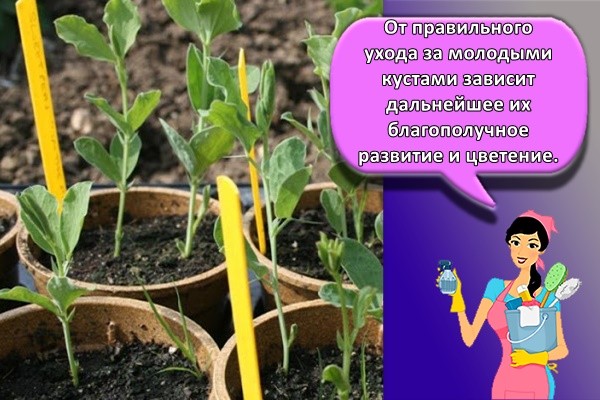
Temperature regime
Containers with crops are kept at a temperature of 20-22 ° C. When the sprouts hatch, it is reduced to 16-17 ° C. At the same time, the covering material is removed.
Illumination
The box is exposed to a south-facing window. If there is not enough light, you need to install an additional source. A good option would be a phytolamp, which is turned on for 2-3 hours a day.
Watering mode
The land under the bushes is irrigated as needed. The soil should be moist, but not wet. Otherwise, pathogenic microorganisms may form. The water is used warm, settled.
Picking
Sweet pea seedlings have a fragile root system, and may be damaged during transplantation. Therefore, it is better to plant seeds immediately in individual containers. The best option is sowing in peat pots.
Top dressing
Seedlings grow rapidly, consuming nutrients from the ground. Top dressing is used to replenish them. For this, 2 grams of Kemira are bred in 1 liter of water... The resulting solution is poured over the ground around the bushes.
Plants begin to harden 1.5-2 weeks before planting. To do this, pots with bushes are taken out into fresh air every day. The initial residence time of a culture on the street is 10-15 minutes. It is gradually increased significantly. Sweet peas are usually planted in open ground in May, after the threat of recurrent frosts has passed.
When to transplant seedlings outdoors
As soon as the ambient temperature stabilizes within 15 degrees, you can start transplanting seedlings. However, if the seedlings have already formed buds or flowers before planting, then they will need to be removed. A week or two before planting in the soil, it is recommended to carry out hardening procedures so that the seedlings gradually get used to the outside temperature. Every day it is necessary to increase the duration of stay in the air. As soon as the young seedlings stand on the street for a day, they can be transplanted into the prepared soil.
Rules:
- It is necessary to plant seedlings in the holes at a distance of 25 cm from each other.
- For high grades, supports must be prepared.
- Annual varieties must be disposed of in the fall. It should be remembered that if you plant annual varieties, then they can be re-planted only after 5 years.
- Since the seedlings are still too sensitive and not fully accustomed to the changing ambient temperature, it is advisable to protect them from the sun for the first few days. To do this, it is enough to build a canopy to protect the plants from ultraviolet rays.
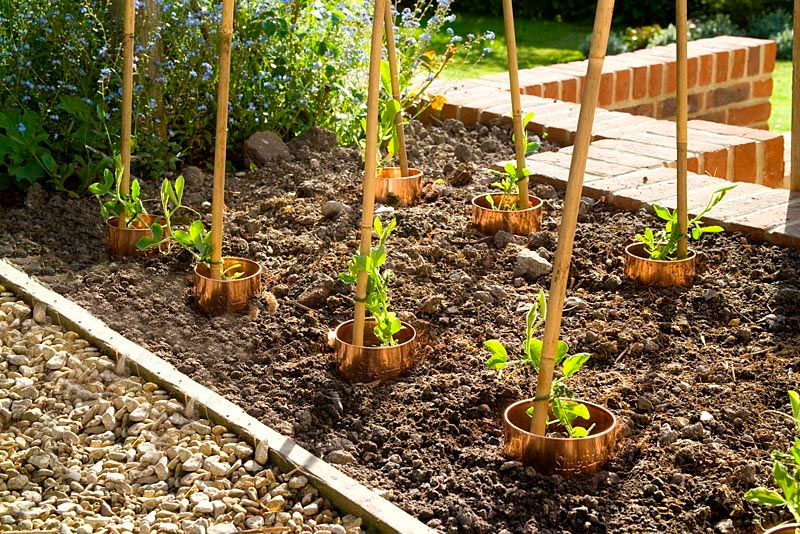
As soon as the ambient temperature stabilizes within 15 degrees, you can start transplanting seedlings into open ground.
The history of the fragrant rank
Before moving on to the topic of care and planting of sweet perennial peas (a photo of it is presented in the article), we will consider a little the history of the plant. Its thickets can be found throughout Europe, South America, and some species - on the slopes of the African mountains. They are fragrant gifts from nature. These plants, which reach a height of two meters, are bred mainly to decorate the backyard.
The name of the plant in Latin is "latirus odoratus". "Odoratus" translates as "smell inhalation", and the word "latirus" was first used by the ancient Greek founder of botany Theophrastus and consists of two words: la - "very" and thoures - "attractive".
There is an official version of the origin of this culture, which says that the English minister of religion, Francisco Kupani, more than three hundred years ago, walking near the walls of his monastery, located on the shores of the Mediterranean Sea, caught the pleasant smell of an unfamiliar plant.
In Russia, in 1938, the Gribovskaya Experimental Breeding Station received several varieties of pea seeds from the English firm "Unwins", and a group of breeders led by Irina Dryagina, Doctor of Agricultural Sciences, began to study this crop. 52 years later, the first twenty varieties of domestic sweet peas appeared.
Perennial sweet peas (photo below), clinging to various supports with their antennae, decorates the walls of balcony loggias and summer cottages. This is probably why the plant is popular among flower growers.
The reason for the demand for the cultivation of this type of plant lies in the fact that pea flowers can tolerate spring and autumn frosts. Compared to other crops, which tend to twine around any support, the fragrant rank grows faster and has a long flowering period. Bouquets of flowers of different shades retain their freshness, smell and attractiveness for a long time. Some plant varieties (undersized) are used for flower beds.
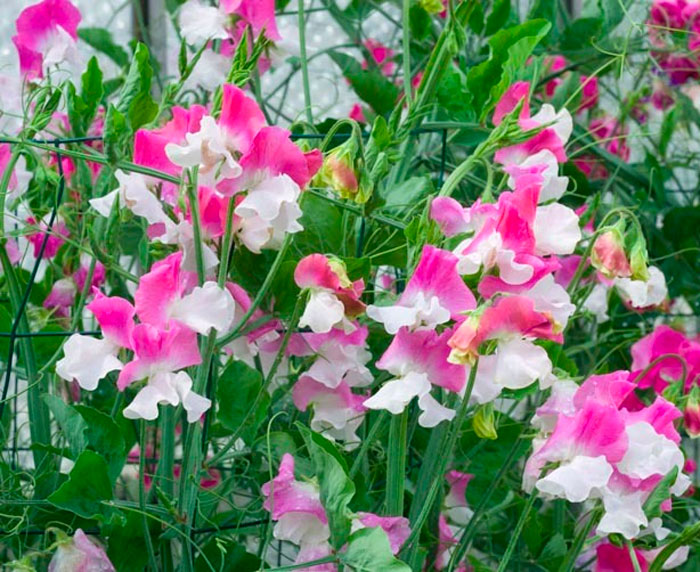
Sweet peas are able to decorate any area
For your information! Currently, bicolor varieties have also been developed, which are becoming more and more popular.
Pea is a perennial, although in certain climatic conditions this fragrant flower is grown as an annual. In addition, thanks to the painstaking work of breeders, many annual varieties have appeared, which are presented in a more diverse range of colors.
Fragrant peas begin to bloom in late June - early July, but the duration of their flowering depends on how they are taken care of. When some simple rules are followed, the plant will delight with numerous flowers until the very frost.
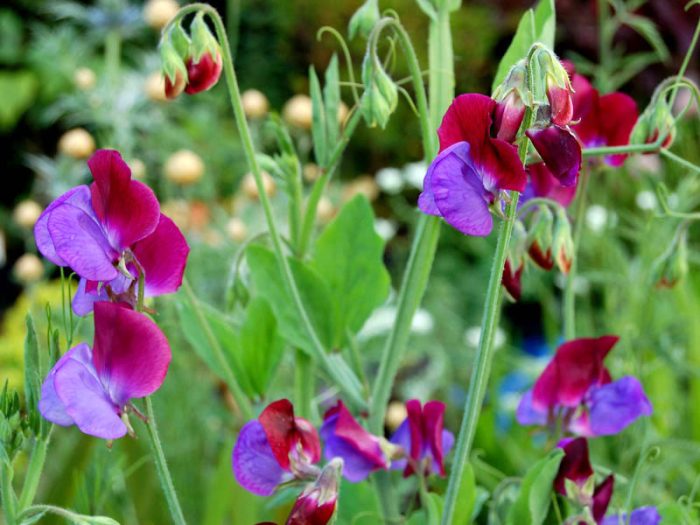
Currently, bicolor pea varieties have been developed
The stems of the peas (ranks) are ribbed, the leaves are complex pinnate of a bright green color. At the ends of the leaves are antennae, thanks to which the plant can curl, clinging to the support. The height of this fragrant plant depends on what variety it is, and can vary from 15-20 cm to 2-2.5 m. The fruits of the ranch are pubescent, not very long beans with several seeds.
Important! Sweet pea seeds are poisonous, so it is better to keep them away from children and animals.
Use in genetics
Gregor Johann Mendel is now considered the "father of modern genetics" because of his work in breeding legumes (peas Pisum sativum) with different properties, and sweet peas were used in the same way. Sweet pea is thus a model organism used in the early stages of genetics, especially by genetics pioneer Reginald Punette. It is a very suitable plant for genetics due to its ability to self-pollinate and easily observable Mendelian traits such as color, height and shape of the petals. Many genetic principles have been discovered or confirmed with sweet peas. This was used by Punette in his early studies of linked inheritance. An additional factor in inheritance was also confirmed by sweet pea when two pure white varieties were crossed, giving rise to a blue hybrid, a blue color requiring two genes derived independently of two white ancestors. Like the blue rose, the yellow sweet pea remains elusive and unlikely without the use of genetic engineering.
Seed propagation and growing of seedlings
Perennial sweet peas can be sown directly into the ground, but more often they are propagated by seedlings. The seed is prepared in April.The seeds can be harvested from your own garden or purchased from specialized stores. On sale, mixtures are more often presented, matched to the height of the bush, but differing in the color and shape of the buds. Varietal plants can also be found if desired. You need to buy them from trusted suppliers who guarantee the authenticity and high quality of the seed.
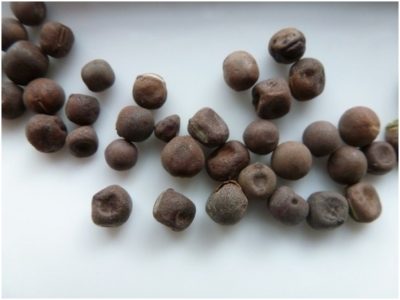
Growing sweet peas from seeds is a very interesting and uncomplicated process that can involve children. With proper germination, failure is almost impossible. First, the prepared material is sorted out, rejecting ugly or too small specimens, the remaining ones are poured with hot water (temperature about 50 degrees). A day later, the emerging hollow seeds are discarded, the liquid is drained from the glass. This procedure will help to slightly soak the dense and tough shell and will significantly increase germination.
The remaining specimens are placed in wet sand until seedlings appear. An alternative is to wrap the seed in a damp cloth that needs to be constantly wetted. After pecking, the seeds are transplanted into prepared soil. Sweet peas prefer a light and nutritious substrate made from a mixture of garden soil, humus, sand and peat. Flowers can be grown in containers, but individual containers made of cardboard, plastic or peat are much more convenient. When transplanting, a young plant is carefully removed from the cassette, the roots are not injured, the flowers take root faster in a new place. Seedlings need to be watered with soft, settled water, preferably rainwater. Fertilizers are not required; peas receive all the necessary nutrients from properly composed soil.
When young seedlings grow up to 15 cm, you can prepare them for moving to a permanent place in the garden or to balcony boxes. You should not delay with the transplant, this can delay flowering. The best time to decorate flower beds is early May. Peas are not afraid of short-term night frosts. The earthen lump is carefully removed from the pot; you cannot shake off the soil from the roots or pull the seedlings by the stem. The plant is placed in a shallow hole and covered with earth. It is not worth deepening it, this can cause rotting of the stem. After planting, the soil around is crushed by hands, the plantings are watered with soft, settled water. With the correct movement, the plants quickly take root, flowering begins in the first decade of July.

Rules for growing a perennial plant
The seeds of perennial sweet peas, a photo of which are presented below, germinate slowly and for a very long time. There are 2 types of ranks - broad-leaved and large-flowered, which can be planted on a private plot and admire this weaving plant for a long time. Broadleaf has a large leaf mass and is used in agriculture as a forage crop. Her flowers are faded, dirty pink, and they don't smell. Large-flowered rank refers to decorative weaving plants, blooms profusely with large, odorless pastel flowers.
To get seedlings of perennial ranks, the seeds are soaked in early February and sown in a light nutritious soil under a film to create a greenhouse effect and prevent the soil from drying out. After the emergence of full shoots, the film is removed and the plants are fed with nitrogen for active growth. To do this, take 1 g of nitrate per liter of water and quickly spill the soil so as not to burn the roots. After the formation of 2-3 true leaves, the plant begins to harden and, after the end of the frost, is planted in the ground. Such an early planting makes it possible for the bush in the first year of life to get stronger over the summer and strengthen the root system. During the first season, a poorly growing plant can be watered with a nitrogen solution at the rate of 1 s. l. for 10 liters of water.
Perennial sweet peas, which can be planted on the south or west side of the building, love bright light and a lot of moisture.The selected location can be slightly shaded, then the lashes will grow more actively to reach a location that is actively lit by the sun.
For the lashes, good support is needed, therefore, a special wall is created for the garden from any kind of mesh materials so that the lashes of the plant do not crumple and rot.
Lattices of open gazebos, pergolas, verandas and other temporary structures available on the site are suitable as a support. Everything that you want to hide from prying eyes in summer and decorate with light flowers can be hidden under the rank of perennial.
From the perennial rank, one should not expect violent flowering in the first year of life. First, a small bush grows from a pea, and it can be transplanted to a permanent place in late summer or next spring. The plant hibernates well, and, gradually increasing the root system, every year it builds up flowering whips in the summer.
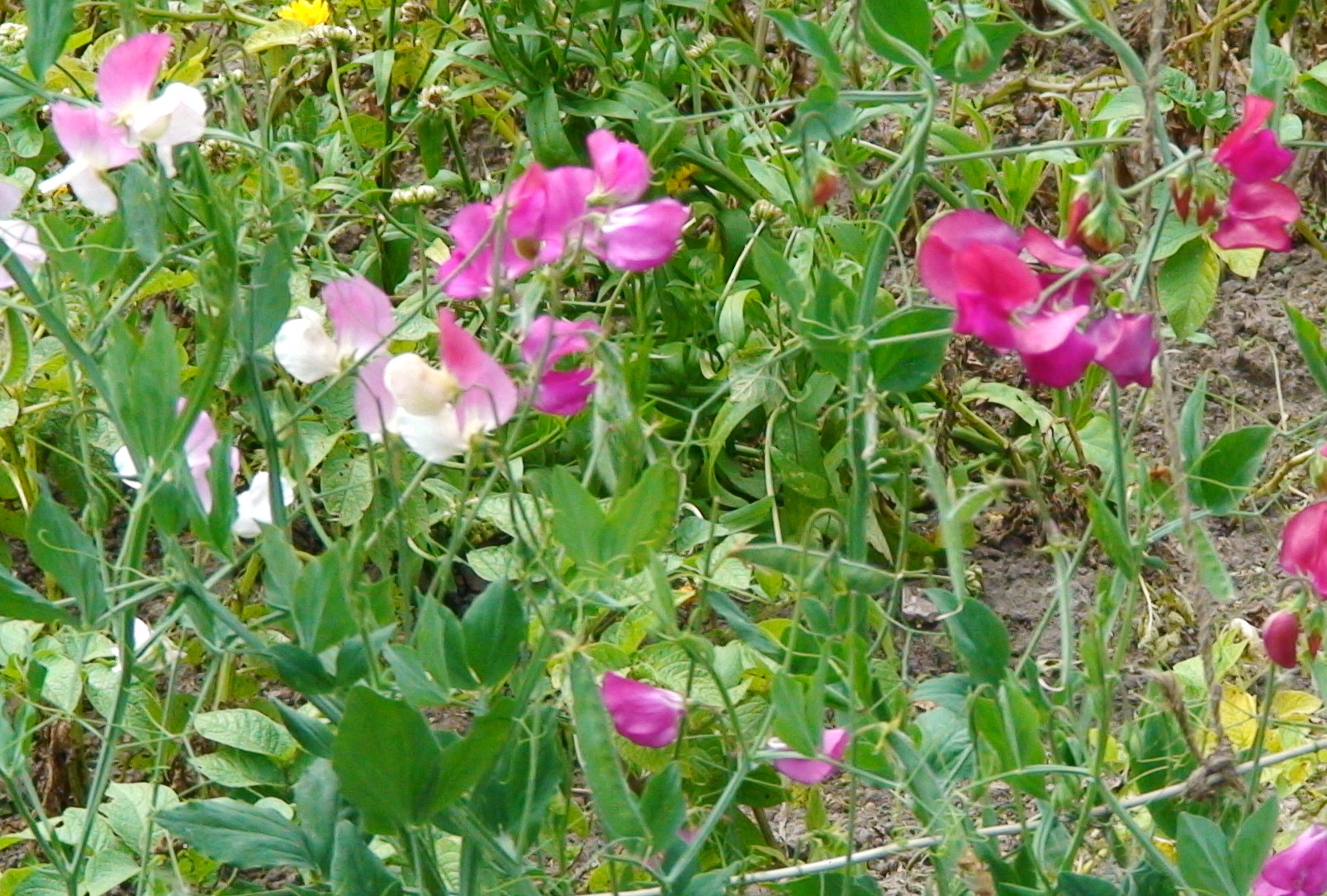
To make the plant comfortable over the winter, its lashes are cut to the root, and the place of growth is covered with sawdust or covered with corrugated cardboard. These two types of shelter will prevent the ground from thawing during short-term winter thaws.
Perennial differs from sweet pea of annual varieties in that its flowers have no aroma and the tones of their petals are paler. The mature bush looks very beautiful and blooms from mid-June to the first frost.
How to deal with powdery mildew
Those who are interested in sweet peas and caring for them should familiarize themselves with the diseases of this plant, as well as with ways to deal with them. Powdery mildew appears on the leaves of young plants in the form of a whitish-gray bloom, which eventually turns gray-brown. There are several folk remedies for controlling powdery mildew:
- Dissolve five grams of laundry soap and baking soda in one liter of water. Spray the infected areas with this solution twice, with an interval of six days.
- In boiling water, add 0.5 cups of wood ash. After two days, add the prepared solution of five grams of laundry soap and a small amount of water to this mixture, mix the solution thoroughly before use. If the plant is severely damaged by powdery mildew, then it should be processed several times, with an interval of five to six days.
- A simpler and rather effective way is the use of various weeds. To do this, fill half a bucket with various finely chopped weeds and fill them with hot water. The prepared mixture should be in the process of fermentation for several days, after which it should be filtered through cheesecloth or other filter material. Treat the affected sweet pea plants in the evening.
Popular varieties of annual sweet peas
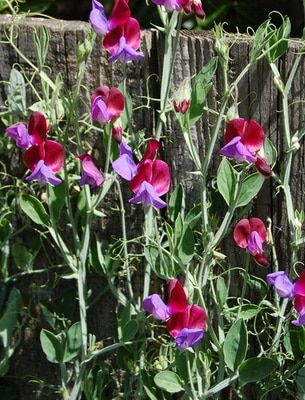
The varieties of sweet peas of the Kazbertson Floribunda garden group are especially popular.
The sail is wide, with a wavy edge, often bent back. Height about 160 cm, multi-stem plant.

Plants of the "Galaxy" variety have up to 12 large flowers on a strong peduncle
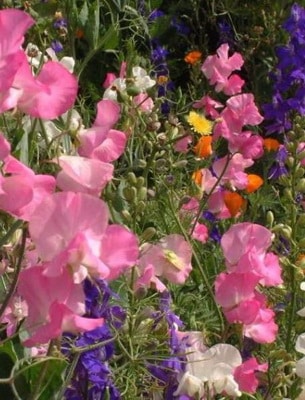
Variety "Mammut" is distinguished by early flowering
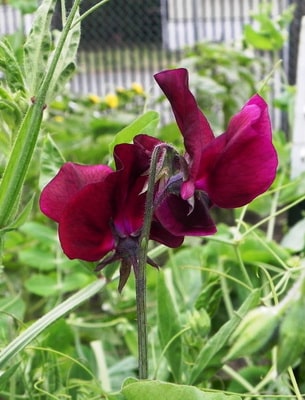
Variety "Multiflora Giganteya" - very early flowering and at the same time forms 6-7 flowers on one peduncle
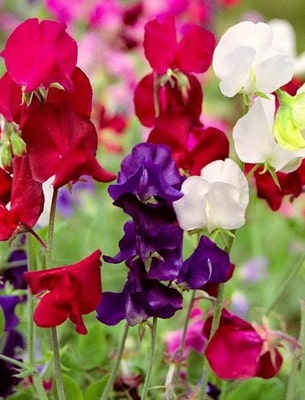
Plants of the variety "Royal Family" with an average flowering period, under good growing conditions, up to eight large flowers bloom on one peduncle
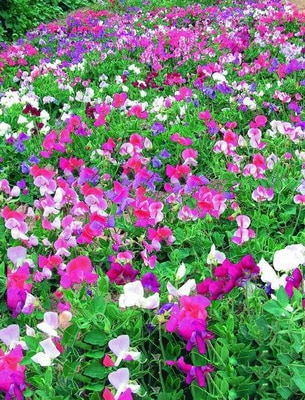
"Matukana"
The rich color of the blossoms of this sweet pea, combined with a wonderful aroma, is a worthy decoration for your balcony or garden. Good for cutting. Shoot length up to 2 m, flowering period: July-August.

Spencer
It is a mixture of tall, large-flowered varieties. Climbing strong, well leafy stems up to 2 m long. Peduncles are strong, resilient, 25-45 cm long.
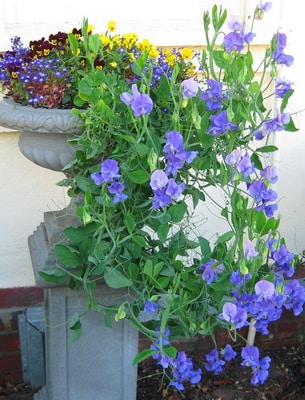
"Cote d'Azur"
The fresh scent combined with the blue color of the flowers will create a soulful atmosphere in the garden. This is one of the best sweet peas for framing a gazebo. The cut will add charm and tenderness to the bouquet.
Of particular interest are fast-growing climbing plants with moth-shaped flowers on long peduncles.
It reaches a height of 2 m, likes a sunny location, reproduces by dividing the bushes and hibernates with light shelter.
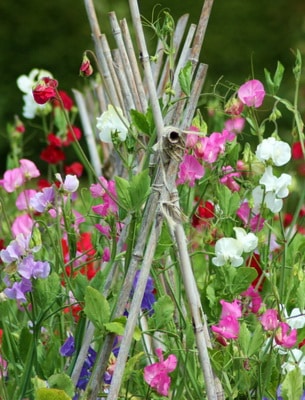
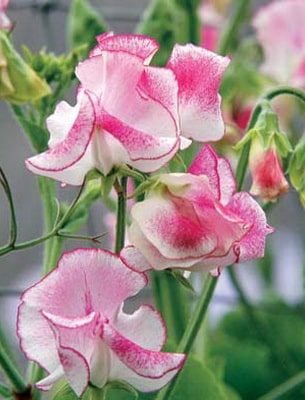
For the cultivation of sweet peas as flowering hedges, wall decoration, gazebos, a special mixture of abundantly flowering perennial varieties "Pearl Scattering" and "Pink Pearls" with large, delicate flowers in luxurious tassels has been created.

"White pearls"
Cold-resistant peas are suitable for vertical gardening, for cutting into small bouquets. Plants up to 1.8 m high with one pair of oblong-oval whitish leaves below.
Check out what the different varieties of sweet peas look like in these photos:
When and how to sow sweet peas
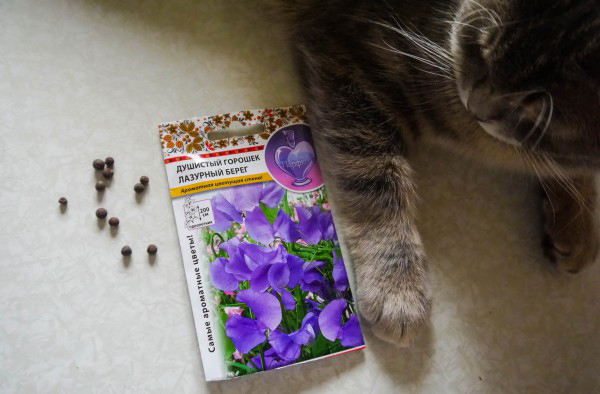
Since sweet peas are southerner in nature, they are planted in warm, sunny areas. He needs a calcareous soil, rich in humus and loose. The site is pre-dug in the fall to a depth of 2 bayonets, since the peas have a deep root system.
Although peas are thermophilic, they tolerate small frosts quite easily. The plant is planted at different times, depending on the region and planting method. Seeds planted in April will turn into adult plants and bloom by June. In order not to bother with the annual cultivation of peas, you can immediately buy perennials in the store.
Since sweet peas do not differ in good germination, it is better to purchase the necessary varieties with a margin. Before any planting method, it is necessary to treat the soil with a boiling manganese solution and cover with foil.
Spring seeds in open ground
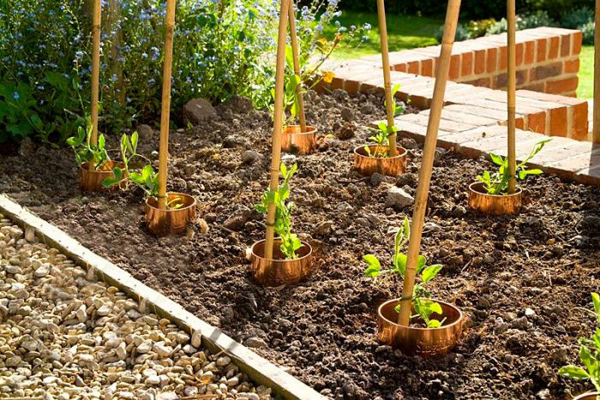
Quite often, sweet peas are sown directly on the site, bypassing the seedling method. Moreover, if it is a perennial, then it will rarely have to be planted, not annually.
Direct sowing is carried out in May.
Experienced florists using the planting method give the following recommendations:
- With an interval of 10 cm, holes are dug 3-4 cm deep;
- The hole is watered and 3 peas are placed in each;
- Supports are installed as needed;
- If desired, the matured seedlings are thinned out.
Spring planting of peas requires mandatory attention regarding watering: the ground should in no way dry out - it should be slightly damp all the time.
Before winter
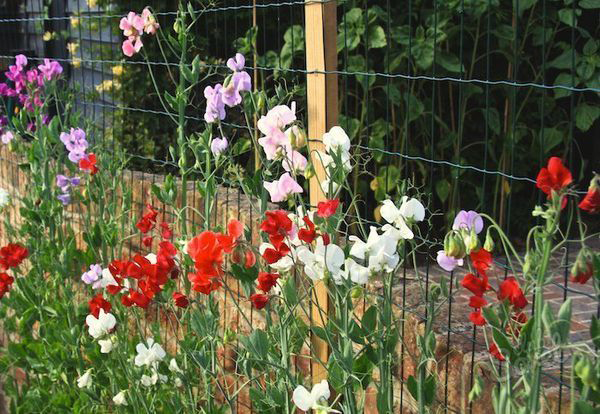
Sweet peas can easily be sown before winter. Cold-resistant seeds winter quite well in the ground, and as soon as spring warmth comes, they begin to germinate.
In comparison with spring sowing, autumn sowing is somewhat more profitable, since it has some advantages:
- Sprouted sprouts from peas hardened over the winter are more resistant to spring frosts and temperature extremes;
- The flowering of such plants is magnificent.
A couple of weeks before the upcoming frost, the beds are deeply dug up, and plant debris is removed.
When frost sets in, shallow (5 cm) grooves are cut on the site. Seeds are spread at intervals of 5 cm and covered with dry soil. Then the crops are rolled away and left to winter.
When and how to plant seeds for seedlings

So that there are no bald spots from non-sprouted seeds in the beds with sweet peas, many growers grow seedlings. It can be planted in separate areas, fill bald spots with it, and decorate landscapes.
Seeds begin to be sown 4-6 weeks before the intended planting.
We can have frosts in the Urals all May. Therefore, I do not sow pea seeds before the end of March - beginning of April.
Since the flower peas have a rather dense skin, they must first be prepared for sowing. Use one of 2 options for this:
- Peas are poured into the jar and poured with hot water + 50 ° C. Then cover with a towel and leave for a day. All grains that have surfaced are removed. Further, the peas are germinated in wet sand.
- The grains of the culture are kept for 12 hours in a special solution Bud.The temperature of the solution should also be + 50 ° C. After that, the peas are transferred to wet sand, where they should be kept for 3-4 days at + 20 ... + 24 ° C.
The hatched seeds are seated in separate deep containers. Use any utensils for this, such as paper cups, edged bottles, juice containers.
It is advisable to purchase a professional soil mixture of Saintpaulia or Rose for seedlings. When self-preparing the soil, you should use garden soil, peat and coarse sand.
After filling the containers with soil, moisten it, put 2-3 peas, and sprinkle with soil on top. When sowing in a common container, the distance between the peas is maintained at 7-8 cm.
Growing perennial sweet peas from seedlings: useful recommendations
To grow seedlings, you should prepare the appropriate soil composition, from garden soil, humus, peat and sand. It is convenient to place the prepared mixture in plastic cups with a capacity of 200 grams.
Place the seeds in holes, no more than two cm deep and pour over with warm water. Water the emerging seedlings constantly for two weeks. At this time, the seedlings develop a root system. After a while, the plant will begin to form the first leaves.
In order for the rank to begin to branch out in the form of a bush and at the same time build up the root system, it is necessary to remove the top (plant growth point) and lateral shoots. In a couple of days, perennial sweet peas (seedlings) are ready for transplanting into the ground.
This final step requires extra care. The seedling should be removed from the container along with an earthen lump, which is enveloped in the roots of sweet peas, and placed in a previously dug hole.
If the seedlings were in a disposable plastic cup, then you can cut it for convenience.
Summer flower care
First of all, it must be protected from drying out, waterlogging, sudden changes in temperature and strong ultraviolet rays. Having eliminated all these damaging factors, there is no doubt that the plant will not get sick and will bloom for a long time.
It is enough to follow a few rules:
- Water regularly with plenty of water and monitor soil moisture. Every week 1 m2 is watered with 30-35 liters of water. If the bushes are intended for collecting seeds for the next season, then they are watered less often.
- Weed the soil from time to time.
- Watch out for support.
- Carry out top dressing. Without it, the condition of the bushes will not worsen, but it is preferable to carry it out. This step will not be superfluous. Top dressing is carried out in 2 stages. Before flowering, it is fertilized with potassium sulfate. The second top dressing occurs at the height of flowering. Apply Agricole or Rosa.
- Protect from pests.
It cannot be pruned. Only one procedure is carried out - cutting of wilted flowers.
Pests and diseases
If the rules of planting, care and prevention of sweet peas are not followed, like all plants, it will be susceptible to various diseases and lesions of pathogenic organisms. To prevent the spread of pathogens, all kinds of drugs are used.
Phyto pests include:
- Nodule weevil. Gnaws leaves, and the larvae attack the roots. Chlorophos is used as a preventive measure.
- The next on the list of parasites is aphids. It feeds on plant sap and spreads viruses. Tsiram or Tsineb helps well against aphids. They treat flower beds with an interval of a couple of weeks.

Pea aphid - garden pest
Diseases:
- Ascochitis. In this disease, spots with clearly drawn borders form on the leaf blades and on the beans. In this case, the plant should be treated with Rogor.
- Peronosporosis. Susceptible to this disease since mid-summer. Its shoots and foliage are affected by a white bloom. After that, the yellowed leaves fall off. They destroy pathogenic microorganisms using colloidal sulfur by processing the leaves.
- Fusarium. With this disease, it is impossible to help the plant.The diseased bush is removed from the flower bed and put on fire.
- Root rot. As in the case of fusarium, the plant cannot be cured.
- Viral mosaic. In which the leaves and stems are covered with patterns. Affected bushes are removed from the flower bed.
For three centuries, sweet peas have been decorating homes and gardens. Due to the fact that the flower is unpretentious, specific care is not required. The main thing is to follow simple rules. Then the bright flowering and aroma will delight the gardener for a long time.
Variegated flower petals, like dancing butterflies, picked up by a light breath of wind, a wide variety of colors and a subtle fragrance will attract the attention of passers-by from June to the onset of winter
This article covered topics that can help you grow extraordinarily beautiful flowers at home. The most favorable time was mentioned when to plant sweet peas for seedlings and how to care for them.
Growing sweet pea seedlings - yes or no?
Some growers unequivocally argue that growing sweet peas through seedlings is an unjustified expenditure of energy. The plant does not withstand transplantation due to the structural features of the root system and the fragility of the stems.
On the other hand, seedless cultivation of climbing varieties of sweet peas leads to late flowering - in the second half of summer. Of course, everyone wants to observe such beauty from the very beginning of summer, therefore, despite the problems with transplantation, many growers still take up growing seedlings. If you want to collect seeds, then you most likely cannot do without seedlings.
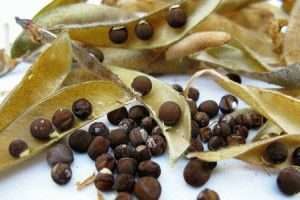
Preparing seeds for planting
Regardless of whether you are planting seeds in seedling cups or directly into the open ground, they need to be well prepared. Florists advise to soak them and wait until they hatch.
This is especially important in the case of using purchased seeds, the quality of which can be questioned. During soaking, it is easy to control the process and see which seeds are worth pinning their hopes on, and which ones will not germinate at all
First, the seeds must be poured with water for a day to swell. Then the water should be drained, and the seeds should be wrapped in a dampened cloth, wrapped in plastic and placed in a warm place. Those that hatch can be sown, the rest can be discarded or try to germinate again.
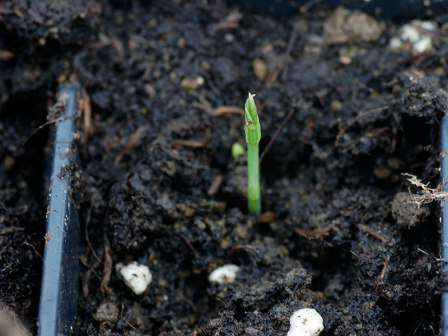
Growing sweet pea seedlings
If you nevertheless decide to exert yourself to grow seedlings and get early flowering of sweet peas, then the following tips will definitely come in handy for you:
For seeding, you need small but deep containers. These can be disposable 200 gram cups. The roots in such a container are densely entwined with an earthen lump, and it will not collapse during transplantation. In smaller containers, the soil will dry out quickly, and a poorly developed root will inhibit the development of seedlings. Immediately after emergence, transfer the container to a bright but cool place. A glazed balcony will work well. If the only option is a window sill, then you need to open the window often. In April, the daylight hours are long enough so that allspice seedlings do not experience an urgent need for additional lighting. At the time of the full development of two true leaves in plants, the growth point must be removed. Side shoots can also be cut, leaving two leaves each. Such a measure will contribute to the active development of the root system. If you also grow seedlings of other crops, you should not be guided by them in the frequency of watering. Remember, sweet peas require much more moisture than other vegetable and ornamental crops. Do not let the ground underneath dry out. Plant plants in open ground at the age of one month - by this time, suitable running conditions should have come. Even if there are frosts in late April or early May, they are small, so sweet peas will easily outlive them.When planting, make every effort so as not to destroy the earthen ball and break the delicate stems of the plant. If possible, create a small shadow over the sprouts for a couple of days.

Now about when to plant a crop. It is ideal to sow allspice seeds for seedlings in early April. You should not rush to land in winter. This will produce thin and weak seedlings.
How and when to plant seeds outdoors
Planting sweet pea seeds outdoors is a more common cultivation method. If the selected variety is perennial, this will have to be done only once every few years. When asked when to plant, we answer: in May. And when asked how to plant, we give recommendations:
Dig holes 3 cm deep at a distance of 8-10 cm from each other. Place 3 seeds in each hole. The land must be watered.
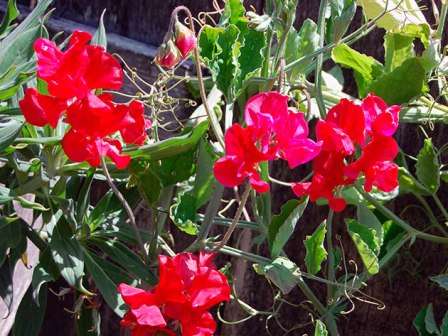
Allspice care, photo
Now is the time to talk about caring for allspice outdoors. Check out the basic tips for growers.
Watering.
As already noted, sweet peas are picky about watering. It quickly absorbs water from the ground. We must warn you - if you rarely appear on your site, then you will not grow a magnificently flowering plant. And one more nuance: the bushes from which you plan to collect seeds need to be watered much less often.
Top dressing.
By and large, sweet peas can do without additional nutrition. But by adding top dressing to the soil, you will achieve a more lush and long-lasting flowering. If you choose to fertilize, choose a chlorine-free fertilizer and don't get carried away with nitrogenous fertilizers.
Sweet pea varieties
Sweet peas are divided into classes: tall, medium-sized and low-growing. Consider which varieties belong to each class.
Tall:
- Spencer. "Aristocrat" with a sugary sweet aroma and white - pink flowers, "Sir Charles" with flowers of scarlet shades, "Sir Arthur" with delicate lilac petals, "Formula of love", dazzling with various flowers.
- Galaxy. Milky Way, Alice, Cremona, Neptune. All of them are distinguished by large inflorescences with corrugated flowers up to 5 cm in diameter.
The undersized group includes varieties: "Mammut", "Cupid", "Billo", "Fantasy" (dwarf pot). Multi-colored rugs are formed from this group.
It is better to cut the flowers of the peas at dawn, while the air is cool. After cutting, the flower buds do not open, so you should wait until all the inflorescences gain color. A sweet pea bouquet can last up to 2 weeks. The plant is perfect for decorating gazebos, hedges, and decorating the walls of buildings.
Perennial grades of rank are not particularly varied in color: more often it is a purple or pink hue. Such peas can grow up to 2 m, while clinging with its antennae to all objects that meet in its path. These varieties must be tied up, since lodging of the stems can provoke their decay and the development of various diseases.
All varieties of peas are usually subdivided into groups:
- Spencer. The varieties are vigorous with powerful stems and peduncles, the upper edges of the petals are wavy;
- Kazberston. The shoots are long, with numerous flowers, thanks to which the plants of this group are simply charming when cut;
- Royal. This group includes early flowering varieties, in which large flowers with upper petals, colored either in lighter, delicate, or, conversely, more saturated, shades;
- Bijou. These are low-growing (about 25-30 cm) plants with large and bright inflorescences. Abundant flowering;
- Pink Cupid. The varieties of this group have a common characteristic feature - the upper petal has a wavy edge. Plants are low (up to 30 cm);
- Fantasy. This group is distinguished by dwarf growth (no more than 20 cm), due to which it is used as a ground cover and as bordering borders.
Sweet peas (its photo is presented above) during the flowering period spreads a pleasant smell and surprises with its abundance of various colors and shades.
There are several hundred varieties of this popular plant. A feature of tall ones is that they are adapted for growing seedlings in greenhouse conditions. They are subsequently transplanted into the soil of the infield. This class includes plants of the Spencer variety. This type of culture reaches a height of up to 2.5 meters, and has a graceful flower shape, with a pleasant smell.
This variety also includes "Aristocrat" with a strong sweet smell, "Sir Charles", "Sir Arthur" and "Formula of Love". The flowers of these plants are large in a variety of colors and shades.
The lowest grade is "Dwarf peas" (up to 20 centimeters). The interest in this variety lies in the fact that these plants, growing, form the appearance of a multi-colored rug.

